
Home » Blog » Bluewater sailboats » The best bluewater sailboats (we analyzed 2,000 boats to find out)

The best bluewater sailboats (we analyzed 2,000 boats to find out)
By Author Fiona McGlynn
Posted on Last updated: May 16, 2023
We analyzed two-thousand bluewater sailboats to bring you a list of proven offshore designs
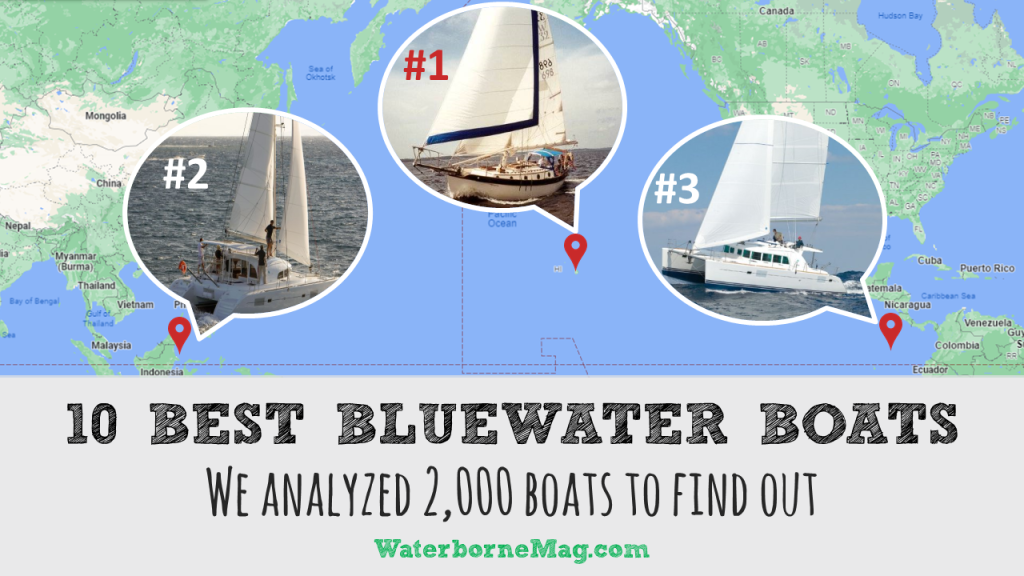
What are the best bluewater sailboats?
This was a question we asked a lot of experienced cruisers when we decided to sail across the Pacific. We needed a boat after all, and we wanted to buy the best bluewater sailboat we could afford.
We heard a lot of strong opinions.
Some sailors thought it was reckless to go offshore in any boat that didn’t have a full keel.
Others prioritized performance, and wouldn’t dream of going anywhere in a slow boat like the Westsail 32 (a.k.a. a “Wet Snail 32”).
Opinions like these left us feeling confused like we had to choose between safety and performance.
If we learned anything from these conversations, it’s that what makes a bluewater boat is a hotly debated topic!
However, there’s a way to cut through all the opinions and get to the bottom of it. The solution is….
We analyzed just under 2,000 boats embarking on ocean crossings (over a 12 year time period) and came up with a list of the ten best bluewater sailboats.
Where did we get our data?
The data for our best bluewater sailboats list comes from 12 years of entries in the Pacific Puddle Jump (PPJ), an annual cross-Pacific rally. We took part in 2017 and had a ball!
You can read about the methodology we used to analyze this data at the bottom of the post.
What do we mean by “best”?
We know, that word is overused on the internet!
Simply, based on our data set, these were the most common makes and models entered in the PPJ cross-Pacific rally. There were at least 10 PPJ rally entries for every make of boat on our top 10 list.
So, these boats are 100% good to go?
No! A bluewater boat isn’t necessarily a seaworthy boat. Almost every cruiser we know made substantial repairs and additions to get their offshore boat ready, adding watermakers , life rafts, solar panels, and more.
Also, you should always have a boat inspected by a professional and accredited marine surveyor before buying it or taking it offshore.
But my bluewater baby boat isn’t on this list!?
There are hundreds of excellent bluewater yachts that are not on this list. For instance, we sailed across the Pacific in a Dufour 35, which didn’t even come close to making our top 10 list.
Choosing the right boat is very much an individual journey.
Where can I find these bluewater boats for sale?
We recognize that a top 10 list won’t get you very far if you’re shopping for a bluewater boat (especially if you’re looking in the used market).
So, to help you find your perfect boat, we’re going to create a big list of bluewater boats that you can use to refine your search on Yachtworld, Craigslist, or any other places to buy a used boat .
Sign up for our newsletter to get our big list of bluewater boats list as soon as it comes out.
We’re also working on a series of posts by size class. For example, if you’re looking for a smaller boat, you can narrow it down to the best bluewater sailboats under 40 feet .
Takeaways from our analysis
There were no big surprises on an individual boat level. All of these makes are considered good cruisers, some of them are even best-selling designs! However, there were a few things that caught our eye.
“Go simple, go small, go now” still holds water
We were thrilled to see the smallest boat in our roundup at the very top of the list! Westsail 32 owners can take pride in their small but mighty yachts (and ignore all those snail-sayers).
While undoubtedly there’s been a trend towards bigger bluewater cruisers in recent years, small cruising sailboats seem to be holding their own. 60% of the monohulls on this list were under 40 feet (if you count the Valiant 40 which sneaks just under at 39.92 feet).
Cat got our tongue
So, we knew catamarans were a thing, but we didn’t fully appreciate HOW popular they’d become!
50% of our top 10 bluewater boat list consists of catamarans—a good fact to toss out the next time you’re trying to garner a happy hour invite on the party boat next door (which will undoubtedly be a catamaran).
Still got it!
We’ve got good news for all you good old boat lovers! 60% of the boats on our list were first built before 2000.
While these older models are less performance-oriented than modern designs, cruisers value these boats for their ability to stand up to rough seas and heavy weather. It just goes to show that solid bones and classic looks never go out of style.
Alright, without further ado, let’s dive into our list of the 10 best bluewater boats!
The 10 best bluewater boats
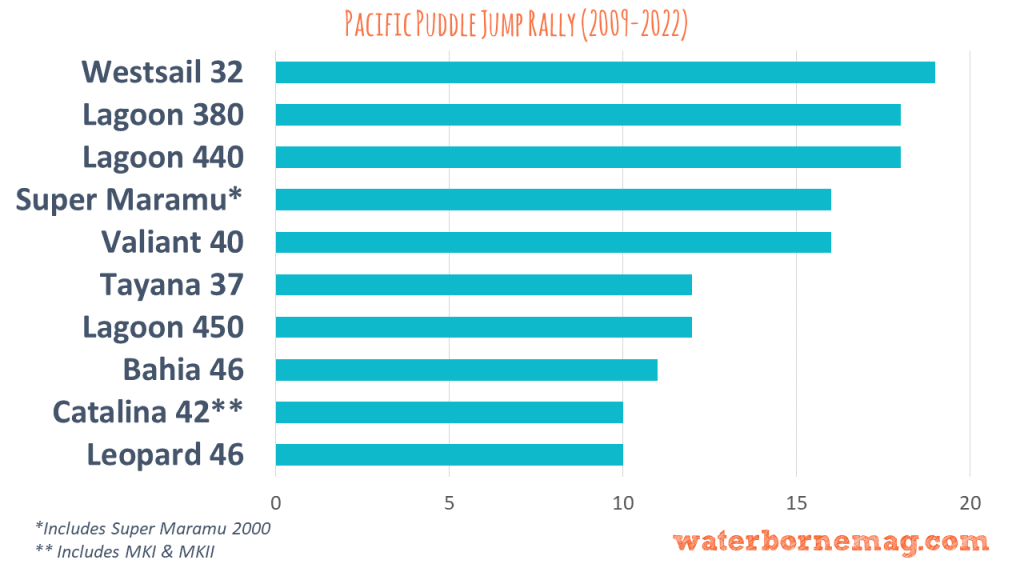
1. Westsail 32
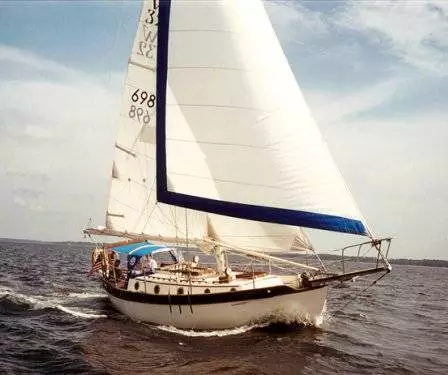
The Westsail 32 is one of the most iconic bluewater cruisers and 19 have set out to cross the Pacific in the PPJ rally since 2009.
In 1973, this small cruising sailboat garnered a 4-page spread in Time magazine. The article inspired many Americans to set sail and the Westsail 32, with its double-ender design, set the standard for what a real bluewater cruiser should look like.
There were approximately 830 built between 1971 and 1980.
This small boat has taken sailors on ocean crossings and circumnavigations. Though considered “slow” by some, the heavily-built Westsail 32 has developed a loyal following for her other excellent offshore cruising characteristics.
If you’re interested in small bluewater sailboats, check out our post on the best small sailboats for sailing around the world .
| LOA | 32.00 ft / 9.75 m |
| First built | 1971 |
| Builder | Westsail (USA) |
| Designer | W. Crealock / W. Atkin |
| Hull type | Long keel, trans. hung rudder |
| Rig type | Cutter |
| Displacement | 19,500 lb / 8,845 kg |
2. Lagoon 380
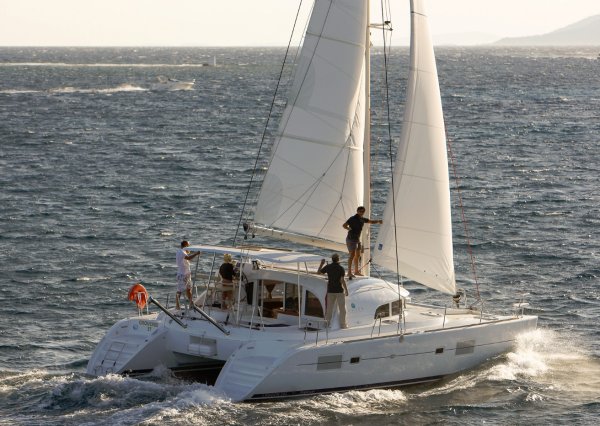
The Lagoon 380 is a reliable, solidly built catamaran and considered roomy for its size. We counted 18 of them in our data set. With over 800 boats built , it may be one of the best-selling catamarans in the world. Like the other boats on this list, the Lagoon 380 has proven itself on long passages and ocean crossings, winning it many loyal fans.
| LOA | 37.89 ft / 11.55 m |
| First built | 2000 |
| Builder | Jeanneau (FRA) |
| Designer | V. Peteghem / L. Prévost |
| type | Cat. twin keel |
| Rig type | Fractional sloop |
| Displacement | 16,005 lb / 7,260 kg |
| More specifications |
3. Lagoon 440
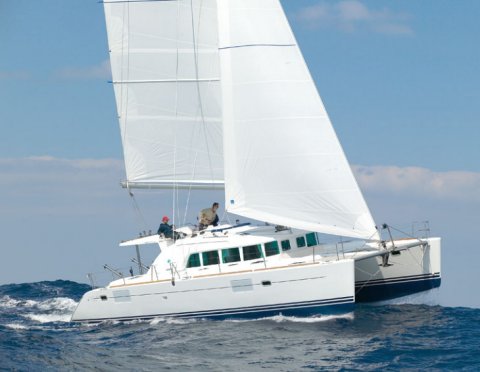
18 Lagoon 440s have set out to cross the Pacific in the PPJ rally since 2009.
Why leave the comforts of home, when you can take them with you? The Lagoon 440 is a luxurious long-range cruiser, offering beautiful wood joinery, spacious accommodations, and a deluxe galley. Oh, and you have the option of an electric boat motor !
SAIL and Sailing Magazine have both done in-depth reviews of the Lagoon 440 if you want to learn more.
| LOA | 44.65 ft / 13.61 m |
| First built | 2004 |
| Builder | Lagoon (FRA) |
| Designer | V. Peteghem / L. Prévost |
| Hull type | Cat. twin keel |
| Rig type | Fractional sloop |
| Displacement | 26,786 lb / 12,150 kg |
4. Amel Super Maramu (incl. SM 2000)
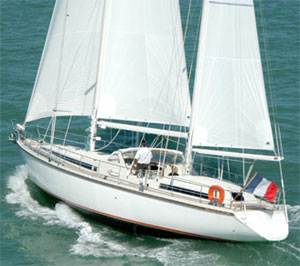
If you follow the adventures of SV Delos on YouTube, you probably know that the star of the show (SV Delos— in case the title didn’t give it away ) is an Amel Super Maramu. These classic bluewater sailboats can be found all over the world, proof they can go the distance.
We counted 16 Amel Super Maramus and Super Maramu 2000s in our list of PPJ entries.
Ready to join the cult of Amel? Read more about the iconic brand in Yachting World.
| LOA | 52.49 ft / 16.00 m |
| First built | 1989 |
| Builder | Amel (FRA) |
| Designer | H. Amel / J. Carteau |
| Hull type | Wing keel |
| Rig type | Masthead ketch |
| Displacement | 35,274 lb / 16,000 kg |
5. Valiant 40
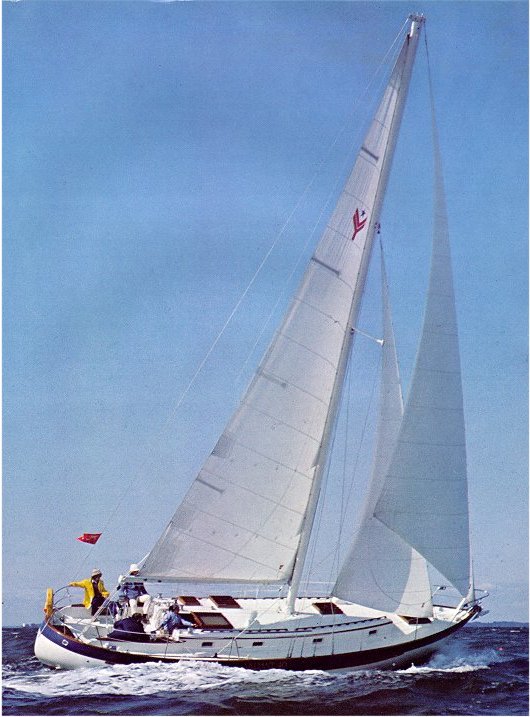
When I interviewed legendary yacht designer, Bob Perry, for Good Old Boat in 2019, he told me that the Valiant 40 was one of the boats that most defined him and marked the real start of his career.
At the time, heavy displacement cruisers were considered sluggish and slow, especially in light winds.
Perry’s innovation with the Valiant 40 was to combine a classic double ender above the waterline, with an IOR racing hull shape below the waterline. The result was the first “performance cruiser”, a blockbuster hit, with over 200 boats built in the 1970s.
It’s no surprise we counted 16 Valiant 40s in our data set.
Cruising World magazine dubbed it “a fast, comfortable, and safe cruising yacht,” and there’s no doubt it’s covered some serious nautical miles.
It’s worth noting that there were blistering problems with hull numbers 120-249 (boats built between 1976 and 1981). Later models did not have this problem. Despite the blistering issues, the Valiant 40 remains one of the most highly thought of bluewater designs.
| LOA | 39.92 ft / 12.17 m |
| First built | 1973 |
| Builder | Uniflite/Valiant (USA) |
| Designer | R. Perry |
| Hull type | Fin keel, rudder on skeg |
| Rig type | Cutter |
| Displacement | 23,520 lb / 10,668 kg |
6. TAYANA 37
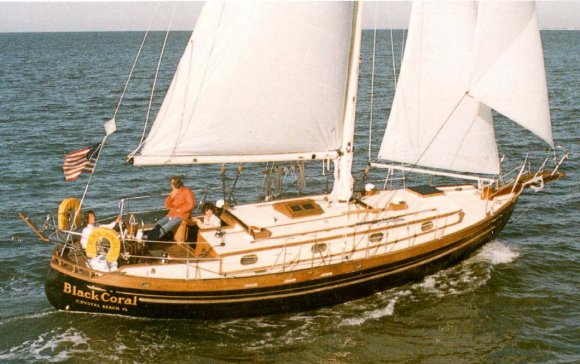
The Tayana 37 is another hugely popular Perry design. The first boat rolled off the production line in 1976 and since then, nearly 600 boats have been built. Beautiful classic lines and a proven track record have won the Tayana 37 a devoted following of offshore enthusiasts.
12 Tayana 37s have set out to cross the Pacific in the PPJ rally since 2009. Read more about the Tayana 37 in this Practical Sailor review .
| LOA | 36.67 ft / 11.18 m |
| First built | 1976 |
| Builder | Ta Yang (TWN) |
| Designer | R. Perry |
| Hull type | Long keel |
| Rig type | Cutter |
| Displacement | 22,500 lb / 10,206 kg |
7. Lagoon 450
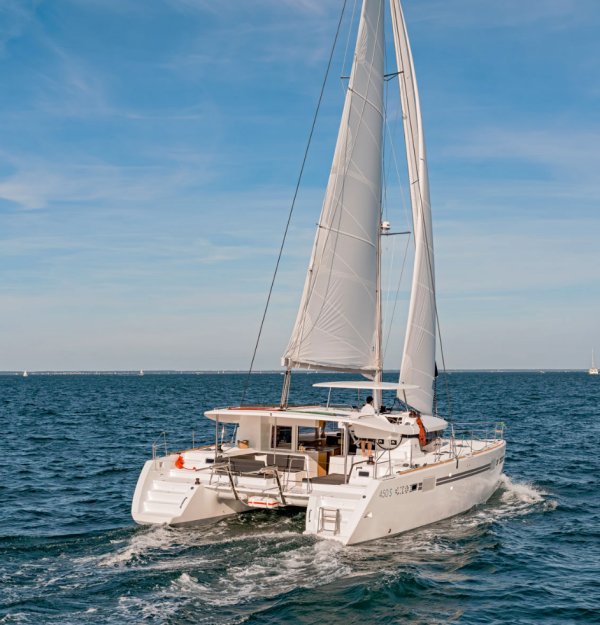
If this list is starting to sound like a paid advertisement, I swear we’re not on Lagoon’s payroll! This is the third Lagoon on our list, but the data doesn’t lie. Lagoon is making some of the best cruising sailboats.
The 450 has been a hot seller for Lagoon, with over 800 built since its launch in 2014. While not a performance cat, the Lagoon 450 travels at a reasonable speed and is brimming with luxury amenities.
At least 12 owners in the PPJ rally chose the Lagoon 450 to take them across the Pacific. It’s no wonder SAIL had so many good things to say about it.
| LOA | 45.80 ft / 13.96 m |
| First built | 2014 |
| Builder | Lagoon (FRA) |
| Designer | V. Peteghem / L. Prévost |
| Hull type | Cat. twin keel |
| Rig type | Fractional sloop |
| Displacement | 33,075 lb / 15,003 kg |
8. Fountaine Pajot Bahia 46
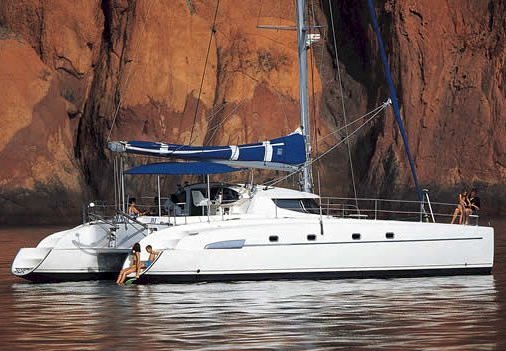
There were 11 Fountaine Pajot Bahia 46s in our data set.
Fountaine Pajot released the Bahia 46 in 1997, a sleek design for traveling long distances. Its generously-sized water and fuel tanks along with ample storage for cruising gear are a real plus for the self-sufficient sailor.
According to Cruising World , “Cruising-cat aficionados should put the Bahia 46 on their “must-see” list.”
| LOA | 46.10 ft / 14.05 m |
| First built | 1997 |
| Builder | Fountaine Pajot (FRA) |
| Designer | Joubert-Nivelt |
| Hull type | Cat. twin keel |
| Rig type | Fractional sloop |
| Displacement | 21,385 lb / 9,700 kg |
| See |
9. Catalina 42 (MKI, MKII)
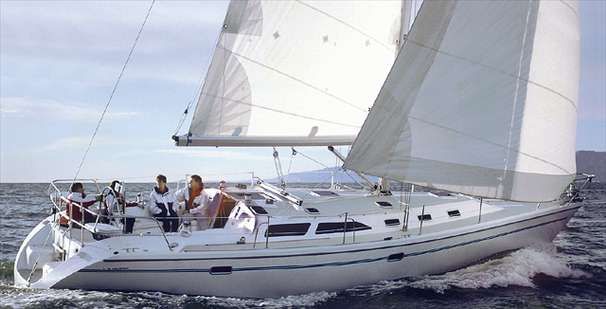
10 Catalina 42s (MKI and MKII) have set out to cross the Pacific in the PPJ rally since 2009.
The Catalina 42 was designed under the guidance of the legendary yacht designer and Catalina’s chief engineer, Gerry Douglas.
One of Catalina’s philosophies is to offer “as much boat for the money as possible,” and the Catalina 42 is no exception. According to Practical Sailor , Catalina aims to price its boats 15% to 20% below major production boats like Hunter and Beneteau.
Practical Sailor has a great in-depth review of the Catalina 42 .
| LOA | 41.86 ft / 12.76 m |
| First built | 1989 |
| Builder | Catalina (USA) |
| Designer | Catalina |
| Hull type | Fin keel, spade rudder |
| Rig type | Masthead sloop |
| Displacement | 20,500 lb / 9,299 kg |
10. Leopard 46
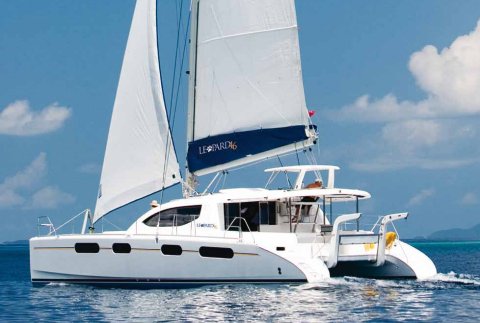
Since 2009, 10 Leopard 46s have embarked on Pacific crossings in the PPJ rally.
Leopards have won legions of fans for their high build quality, robust engineering, and excellent performance.
The Leopard 46 also boasts something of a racing pedigree. It was built in South Africa by Robertson and Caine and designed by Gino Morelli and Pete Melvin, who came up with the record-breaking catamaran Playstation / Cheyenne 125 .
Read more about the Leopard 46 in this Cruising World review .
| LOA | 46.32 ft / 14.12 m |
| First built | 2006 |
| Builder | Robertson & Caine (RSA) |
| Designer | Morelli & Melvin |
| Hull type | Cat. twin keel |
| Rig type | Fractional sloop |
| Displacement | 24,206 lb / 10,980 kg |
Methodology
What the data is and isn’t.
The PPJ data was a real boon because it reflects a wide range of cruising boats: small, big, old, new, expensive, and affordable. We think this may be because the PPJ is a very financially accessible rally—the standard entry cost is $125 or $100 if you’re under 35 (age or boat length!).
We did look at data from other (pricier) rallies but found that the results skewed towards more expensive boats.
Needless to say, the data we used is just a sample of the bluewater boats that crossed the Pacific over the last 10+ years. Many cruisers cross oceans without participating in a rally!
Entries vs. completions
The data we used is a list of the PPJ entries, not necessarily the boats that completed the rally. In instances where we saw the same boat entered multiple years in a row, we assumed they’d postponed their crossing and deleted all but the latest entry to avoid double counting.
Boat make variations
The world of boat building and naming can get pretty complicated. Sometimes a manufacturer changes a boat’s name a year or two into production, other times the name remains the same but the boat undergoes a dramatic update.
For the most part, we’ve used SailboatData.com’s classification system (if they list the boats separately, then we have also), except where there are two separately listed models that have the same LOA, beam, and displacement.
Fiona McGlynn is an award-winning boating writer who created Waterborne as a place to learn about living aboard and traveling the world by sailboat. She has written for boating magazines including BoatUS, SAIL, Cruising World, and Good Old Boat. She’s also a contributing editor at Good Old Boat and BoatUS Magazine. In 2017, Fiona and her husband completed a 3-year, 13,000-mile voyage from Vancouver to Mexico to Australia on their 35-foot sailboat.
Terms and Conditions - Privacy Policy
- Yachting World
- Digital Edition

43 of the best bluewater sailboat designs of all time
- January 5, 2022
How do you choose the right yacht for you? We highlight the very best bluewater sailboat designs for every type of cruising

Which yacht is the best for bluewater boating? This question generates even more debate among sailors than questions about what’s the coolest yacht , or the best for racing. Whereas racing designs are measured against each other, cruising sailors get very limited opportunities to experience different yachts in real oceangoing conditions, so what is the best bluewater sailboat?
Here, we bring you our top choices from decades of designs and launches. Over the years, the Yachting World team has sailed these boats, tested them or judged them for European Yacht of the Year awards, and we have sifted through the many to curate a selection that we believe should be on your wishlist.
Making the right choice may come down to how you foresee your yacht being used after it has crossed an ocean or completed a passage: will you be living at anchor or cruising along the coast? If so, your guiding requirements will be space, cabin size, ease of launching a tender and anchoring closer to shore, and whether it can comfortably accommodate non-expert-sailor guests.
Article continues below…

The perfect boat: what makes an ideal offshore cruising yacht?
Choosing a boat for offshore cruising is not a decision to be taken lightly. I have researched this topic on…

European Yacht of the Year 2019: Best luxury cruisers
Before the sea trials began, I would have put money on a Hallberg-Rassy or the Wauquiez winning an award. The…
All of these considerations have generated the inexorable rise of the bluewater catamaran – monohulls can’t easily compete on these points. We have a full separate feature on the best bluewater multihulls of all time and here we mostly focus on monohulls. The only exceptions to that rule are two multihulls which made it into our best bluewater sailboats of 2022 list.
As so much of making the right choice is selecting the right boat for the venture in mind, we have separated out our edit into categories: best for comfort; for families; for performance; and for expedition or high latitudes sailing .
Best bluewater sailboats of 2022
The new flagship Allures 51.9, for example, is a no-nonsense adventure cruising design built and finished to a high standard. It retains Allures’ niche of using aluminium hulls with glassfibre decks and superstructures, which, the yard maintains, gives the optimum combination of least maintenance and less weight higher up. Priorities for this design were a full beam aft cabin and a spacious, long cockpit. Both are excellent, with the latter, at 6m long, offering formidable social, sailing and aft deck zones.
It likes some breeze to come to life on the wheel, but I appreciate that it’s designed to take up to five tonnes payload. And I like the ease with which you can change gears using the furling headsails and the positioning of the powerful Andersen winches inboard. The arch is standard and comes with a textile sprayhood or hard bimini.
Below decks you’ll find abundant headroom and natural light, a deep U-shape galley and cavernous stowage. For those who like the layout of the Amel 50 but would prefer aluminium or shoal draught, look no further.
Allures 51.9 price: €766,000
The Ovni 370 is another cunning new aluminum centreboard offering, a true deck saloon cruiser for two. The designers say the biggest challenge was to create a Category A ocean going yacht at this size with a lifting keel, hence the hull had to be very stable.
Enjoyable to helm, it has a practical, deep cockpit behind a large sprayhood, which can link to the bimini on the arch. Many of its most appealing features lie in the bright, light, contemporary, clever, voluminous interior, which has good stowage and tankage allocation. There’s also a practical navstation, a large workroom and a vast separate shower. I particularly like the convertible saloom, which can double as a large secure daybed or pilot berth.
Potentially the least expensive Category A lift keel boat available, the Ovni will get you dreaming of remote places again.
Ovni 370 price: €282,080

There’s no shortage of spirit in the Windelo 50. We gave this a sustainability award after it’s founders spent two years researching environmentally-friendly composite materials, developing an eco-composite of basalt fibre and recycled PET foam so it could build boats that halve the environmental impact of standard glassfibre yachts.
The Windelo 50 is an intriguing package – from the styling, modular interior and novel layout to the solar field on the roof and the standard electric propulsion, it is completely fresh.
Windelo 50 price: €795,000
Best bluewater sailboat of 2022 – Outremer 55
I would argue that this is the most successful new production yacht on the market. Well over 50 have already sold (an equipped model typically costs €1.6m) – and I can understand why. After all, were money no object, I had this design earmarked as the new yacht I would most likely choose for a world trip.
Indeed 55 number one Sanya, was fully equipped for a family’s world cruise, and left during our stay for the Grand Large Odyssey tour. Whereas we sailed Magic Kili, which was tricked up with performance options, including foam-cored deckheads and supports, carbon crossbeam and bulkheads, and synthetic rigging.
At rest, these are enticing space ships. Taking one out to sea is another matter though. These are speed machines with the size, scale and loads to be rightly weary of. Last month Nikki Henderson wrote a feature for us about how to manage a new breed of performance cruising cats just like this and how she coaches new owners. I could not think of wiser money spent for those who do not have ample multihull sailing experience.
Under sail, the most fun was obviously reserved for the reaching leg under asymmetric, where we clocked between 11-16 knots in 15-16 knots wind. But it was the stability and of those sustained low teen speeds which really hit home – passagemaking where you really cover miles.
Key features include the swing helms, which give you views from outboard, over the coachroof or from a protected position in the cockpit through the coachroof windows, and the vast island in the galley, which is key to an open plan main living area. It helps provide cavernous stowage and acts as the heart of the entertaining space as it would in a modern home. As Danish judge Morten Brandt-Rasmussen comments: “Apart from being the TGV of ocean passages the boat offers the most spacious, open and best integration of the cockpit and salon areas in the market.”
Outremer has done a top job in packing in the creature comforts, stowage space and payload capacity, while keeping it light enough to eat miles. Although a lot to absorb and handle, the 55 offers a formidable blend of speed and luxury cruising.
Outremer 55 price: €1.35m
Best bluewater sailboats for comfort
This is the successor to the legendary Super Maramu, a ketch design that for several decades defined easy downwind handling and fostered a cult following for the French yard. Nearly a decade old, the Amel 55 is the bridge between those world-girdling stalwarts and Amel’s more recent and totally re-imagined sloop designs, the Amel 50 and 60.
The 55 boasts all the serious features Amel aficionados loved and valued: a skeg-hung rudder, solidly built hull, watertight bulkheads, solid guardrails and rampart bulwarks. And, most noticeable, the solid doghouse in which the helmsman sits in perfect shelter at the wheel.
This is a design to live on comfortably for long periods and the list of standard features just goes on and on: passarelle; proper sea berths with lee cloths; electric furling main and genoa; and a multitude of practical items that go right down to a dishwasher and crockery.
There’s no getting around the fact these designs do look rather dated now, and through the development of easier sail handling systems the ketch rig has fallen out of fashion, but the Amel is nothing short of a phenomenon, and if you’ve never even peeked on board one, you really have missed a treat.
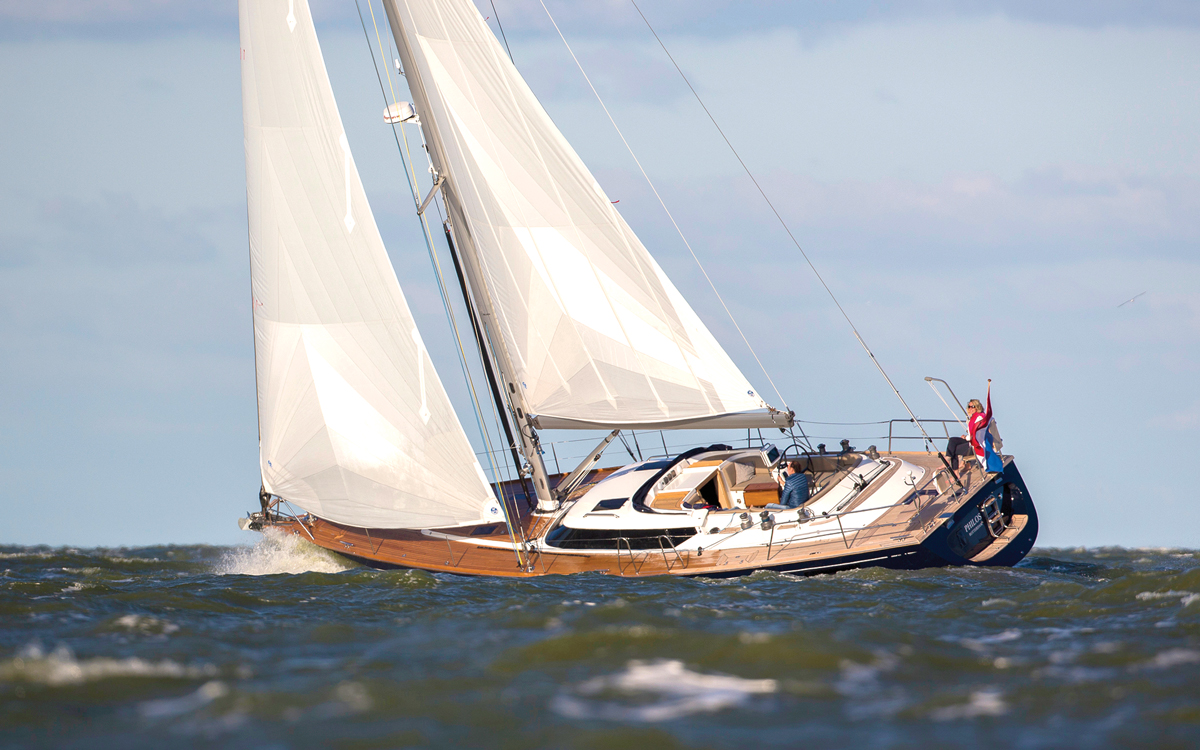
Photo: Sander van der Borch
Contest 50CS
A centre cockpit cruiser with true longevity, the Contest 50CS was launched by Conyplex back in 2003 and is still being built by the family-owned Dutch company, now in updated and restyled form.
With a fully balanced rudder, large wheel and modern underwater sections, the Contest 50CS is a surprisingly good performer for a boat that has a dry weight of 17.5 tonnes. Many were fitted with in-mast furling, which clearly curtails that performance, but even without, this boat is set up for a small crew.
Electric winches and mainsheet traveller are all easy to reach from the helm. On our test of the Contest 50CS, we saw for ourselves how two people can gybe downwind under spinnaker without undue drama. Upwind, a 105% genoa is so easy to tack it flatters even the weediest crewmember.
Down below, the finish level of the joinery work is up there among the best and the interior is full of clever touches, again updated and modernised since the early models. Never the cheapest bluewater sailing yacht around, the Contest 50CS has remained in demand as a brokerage buy. She is a reassuringly sure-footed, easily handled, very well built yacht that for all those reasons has stood the test of time.
This is a yacht that would be well capable of helping you extend your cruising grounds, almost without realising it.
Read more about the Contest 50CS and the new Contest 49CS

Photo: Rick Tomlinson
Hallberg-Rassy 48 Mk II
For many, the Swedish Hallberg-Rassy yard makes the quintessential bluewater cruiser for couples. With their distinctive blue cove line, these designs are famous for their seakindly behaviour, solid-as-a-rock build and beautifully finished, traditional interiors.
To some eyes, Hallberg-Rassys aren’t quite cool enough, but it’s been company owner Magnus Rassy’s confidence in the formula and belief in incremental ‘step-by-step’ evolution that has been such an exceptional guarantor of reliable quality, reputation and resale value.
The centre cockpit Hallberg-Rassy 48 epitomises the concept of comfort at sea and, like all the Frers-designed Hallberg-Rassys since the 1990s, is surprisingly fleet upwind as well as steady downwind. The 48 is perfectly able to be handled by a couple (as we found a few years back in the Pacific), and could with no great effort crack out 200-mile days.
The Hallberg-Rassy 48 was launched nearly a decade ago, but the Mk II from 2014 is our pick, updated with a more modern profile, larger windows and hull portlights that flood the saloon and aft cabin with light. With a large chart table, secure linear galley, heaps of stowage and space for bluewater extras such as machinery and gear, this yacht pretty much ticks all the boxes.

Discovery 55
First launched in 2000, the Discovery 55 has stood the test of time. Designed by Ron Holland, it hit a sweet spot in size that appealed to couples and families with world girdling plans.
Elegantly styled and well balanced, the 55 is also a practical design, with a deep and secure cockpit, comfortable seating, a self-tacking jib, dedicated stowage for the liferaft , a decent sugar scoop transom that’s useful for swimming or dinghy access, and very comfortable accommodation below. In short, it is a design that has been well thought out by those who’ve been there, got the bruises, stubbed their toes and vowed to change things in the future if they ever got the chance.
Throughout the accommodation there are plenty of examples of good detailing, from the proliferation of handholds and grabrails, to deep sinks in the galley offering immediate stowage when under way and the stand up/sit down showers. Stowage is good, too, with plenty of sensibly sized lockers in easily accessible positions.
The Discovery 55 has practical ideas and nifty details aplenty. She’s not, and never was, a breakthrough in modern luxury cruising but she is pretty, comfortable to sail and live on, and well mannered.
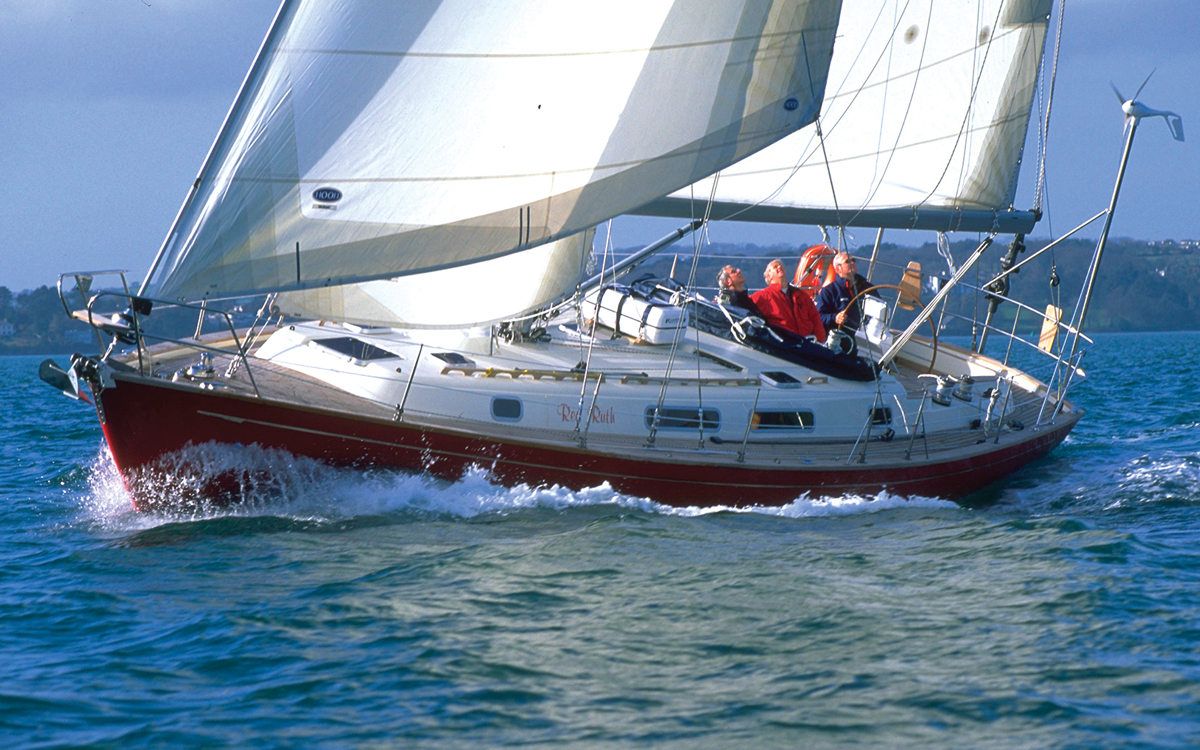
Photo: Latitudes Picture Library
You can’t get much more Cornish than a Rustler. The hulls of this Stephen Jones design are hand-moulded and fitted out in Falmouth – and few are more ruggedly built than this traditional, up-for-anything offshore cruiser.
She boasts an encapsulated lead keel, eliminating keel bolts and creating a sump for generous fuel and water tankage, while a chunky skeg protects the rudder. She is designed for good directional stability and load carrying ability. These are all features that lend this yacht confidence as it shoulders aside the rough stuff.
Most of those built have had a cutter rig, a flexible arrangement that makes sense for long passages in all sea and weather conditions. Down below, the galley and saloon berths are comfortable and sensible for living in port and at sea, with joinery that Rustler’s builders are rightly proud of.
As modern yachts have got wider, higher and fatter, the Rustler 42 is an exception. This is an exceptionally well-mannered seagoing yacht in the traditional vein, with elegant lines and pleasing overhangs, yet also surprisingly powerful. And although now over 20 years old, timeless looks and qualities mean this design makes her look ever more like a perennial, a modern classic.
The definitive crossover size, the point at which a yacht can be handled by a couple but is just large enough to have a professional skipper and be chartered, sits at around the 60ft mark. At 58ft 8in, the Oyster 575 fitted perfectly into this growing market when launched in 2010. It went on to be one of the most popular models from the yard, and is only now being superseded by the newer Rob Humphreys-designed Oyster 565 (just launched this spring).
Built in various configurations with either a deep keel, shoal draught keel or centreboard with twin rudders, owners could trade off better performance against easy access to shallower coves and anchorages. The deep-bodied hull, also by Rob Humphreys, is known for its easy motion at sea.
Some of the Oyster 575’s best features include its hallmark coachroof windows style and centre cockpit – almost everyone will know at first glance this is an Oyster – and superb interior finish. If she has a flaw, it is arguably the high cockpit, but the flip side is the galley headroom and passageway berth to the large aft stateroom.
This design also has a host of practical features for long-distance cruising, such as high guardrails, dedicated liferaft stowage, a vast lazarette for swallowing sails, tender, fenders etc, and a penthouse engine room.

Privilege Serie 5
A true luxury catamaran which, fully fitted out, will top €1m, this deserves to be seen alongside the likes of the Oyster 575, Gunfleet 58 and Hallberg-Rassy 55. It boasts a large cockpit and living area, and a light and spacious saloon with an emphasis on indoor-outdoor living, masses of refrigeration and a big galley.
Standout features are finish quality and solid build in a yacht designed to take a high payload, a secure walkaround deck and all-round views from the helm station. The new Privilege 510 that will replace this launches in February 2020.
Gunfleet 43
It was with this Tony Castro design that Richard Matthews, founder of Oyster Yachts, launched a brand new rival brand in 2012, the smallest of a range stretching to the flagship Gunfleet 74. The combination of short overhangs and centre cockpit at this size do make the Gunfleet 43 look modern if a little boxy, but time and subsequent design trends have been kind to her lines, and the build quality is excellent. The saloon, galley and aft cabin space is exceptional on a yacht of this size.

Photo: David Harding
Conceived as a belt-and-braces cruiser, the Kraken 50 launched last year. Its unique points lie underwater in the guise of a full skeg-hung rudder and so-called ‘Zero Keel’, an encapsulated long keel with lead ballast.
Kraken Yachts is the brainchild of British businessman and highly experienced cruiser Dick Beaumont, who is adamant that safety should be foremost in cruising yacht design and build. “There is no such thing as ‘one yacht for all purposes’… You cannot have the best of all worlds, whatever the salesman tells you,” he says.
Read our full review of the Kraken 50 .

Wauquiez Centurion 57
Few yachts can claim to be both an exciting Med-style design and a serious and practical northern European offshore cruiser, but the Wauquiez Centurion 57 tries to blend both. She slightly misses if you judge solely by either criterion, but is pretty and practical enough to suit her purpose.
A very pleasant, well-considered yacht, she is impressively built and finished with a warm and comfortable interior. More versatile than radical, she could be used for sailing across the Atlantic in comfort and raced with equal enjoyment at Antigua Sailing Week .

A modern classic if ever there was one. A medium to heavy displacement yacht, stiff and easily capable of standing up to her canvas. Pretty, traditional lines and layout below.

Photo: Voyage of Swell
Well-proven US legacy design dating back to the mid-1960s that once conquered the Transpac Race . Still admired as pretty, with slight spoon bow and overhanging transom.

Capable medium displacement cruiser, ideal size and good accommodation for couples or family cruising, and much less costly than similar luxury brands.

Photo: Peter Szamer
Swedish-built aft cockpit cruiser, smaller than many here, but a well-built and finished, super-durable pocket ocean cruiser.
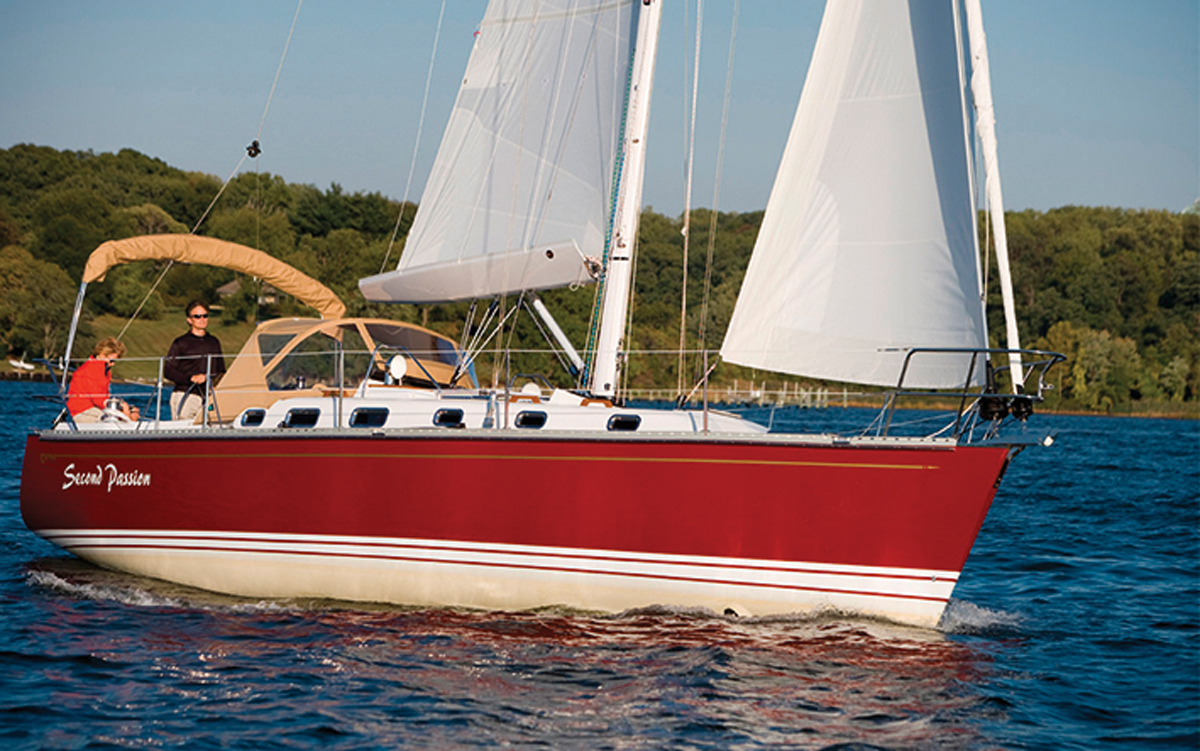
Tartan 3700
Designed as a performance cruiser there are nimbler alternatives now, but this is still an extremely pretty yacht.
Broker ’ s choice

Discovery 55 Brizo
This yacht has already circumnavigated the globe and is ‘prepared for her next adventure,’ says broker Berthon. Price: £535,000 + VAT

Oyster 575 Ayesha
‘Stunning, and perfectly equipped for bluewater cruising,’ says broker Ancasta International. Price: £845,000 (tax not paid)
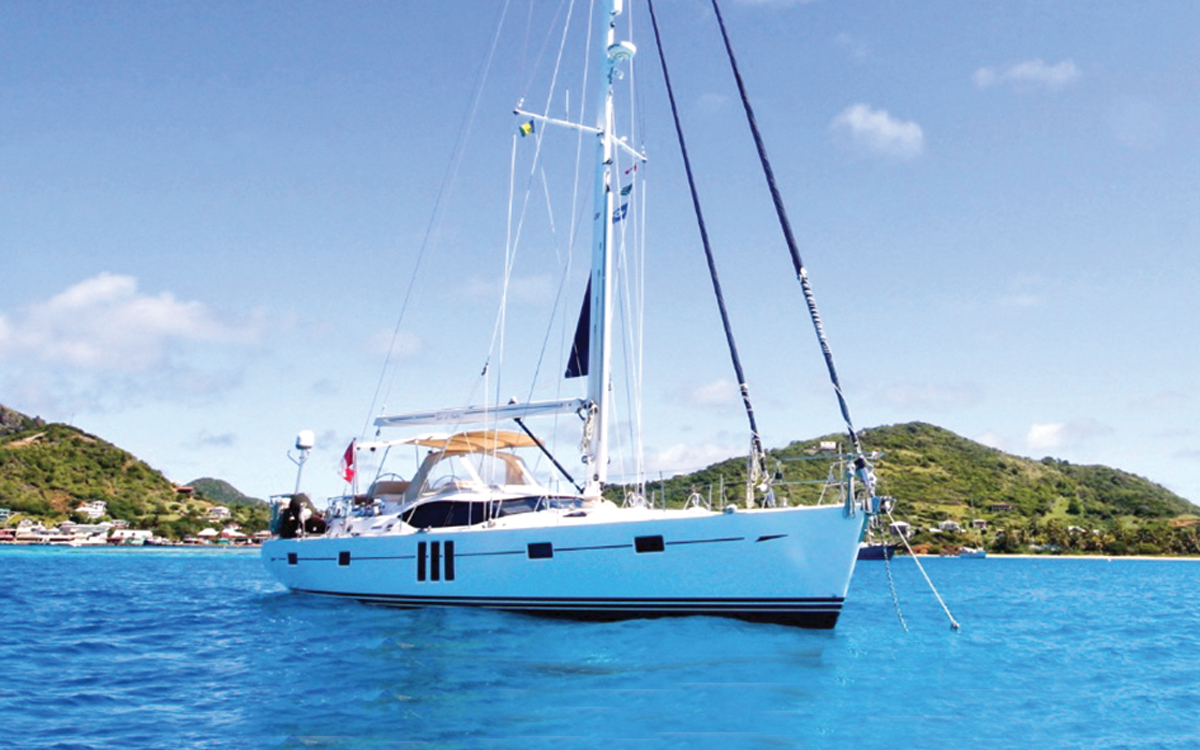
Oyster 575 Pearls of Nautilus
Nearly new and with a high spec, this Oyster Brokerage yacht features American white oak joinery and white leather upholstery and has a shoal draught keel. Price: $1.49m
Best bluewater yachts for performance
The Frers-designed Swan 54 may not be the newest hull shape but heralded Swan’s latest generation of displacement bluewater cruisers when launched four years ago. With raked stem, deep V hull form, lower freeboard and slight curve to the topsides she has a more timeless aesthetic than many modern slab-sided high volume yachts, and with that a seakindly motion in waves. If you plan to cover many miles to weather, this is probably the yacht you want to be on.

Photo: Carlo Borlenghi
Besides Swan’s superlative build quality, the 54 brings many true bluewater features, including a dedicated sail locker. There’s also a cockpit locker that functions as a utility cabin, with potential to hold your generator and washing machine, or be a workshop space.
The sloping transom opens out to reveal a 2.5m bathing platform, and although the cabins are not huge there is copious stowage space. Down below the top-notch oak joinery is well thought through with deep fiddles, and there is a substantial nav station. But the Swan 54 wins for handling above all, with well laid-out sail controls that can be easily managed between a couple, while offering real sailing enjoyment to the helmsman.

Photo: Graham Snook
The Performance Cruiser winner at the 2019 European Yacht of the Year awards, the Arcona 435 is all about the sailing experience. She has genuine potential as a cruiser-racer, but her strengths are as an enjoyable cruiser rather than a full-blown liveaboard bluewater boat.
Build quality is excellent, there is the option of a carbon hull and deck, and elegant lines and a plumb bow give the Arcona 435 good looks as well as excellent performance in light airs. Besides slick sail handling systems, there are well thought-out features for cruising, such as ample built-in rope bins and an optional semi-closed stern with stowage and swim platform.

Outremer 51
If you want the space and stability of a cat but still prioritise sailing performance, Outremer has built a reputation on building catamarans with true bluewater characteristics that have cruised the planet for the past 30 years.
Lighter and slimmer-hulled than most cruising cats, the Outremer 51 is all about sailing at faster speeds, more easily. The lower volume hulls and higher bridgedeck make for a better motion in waves, while owners report that being able to maintain a decent pace even under reduced canvas makes for stress-free passages. Deep daggerboards also give good upwind performance.
With bucket seats and tiller steering options, the Outremer 51 rewards sailors who want to spend time steering, while they’re famously well set up for handling with one person on deck. The compromise comes with the interior space – even with a relatively minimalist style, there is less cabin space and stowage volume than on the bulkier cats, but the Outremer 51 still packs in plenty of practical features.

The Xc45 was the first cruising yacht X-Yachts ever built, and designed to give the same X-Yachts sailing experience for sailors who’d spent years racing 30/40-footer X- and IMX designs, but in a cruising package.
Launched over 10 years ago, the Xc45 has been revisited a few times to increase the stowage and modernise some of the styling, but the key features remain the same, including substantial tanks set low for a low centre of gravity, and X-Yachts’ trademark steel keel grid structure. She has fairly traditional styling and layout, matched with solid build quality.
A soft bilge and V-shaped hull gives a kindly motion in waves, and the cockpit is secure, if narrow by modern standards.

A three or four cabin catamaran that’s fleet of foot with high bridgedeck clearance for comfortable motion at sea. With tall daggerboards and carbon construction in some high load areas, Catana cats are light and quick to accelerate.

Sweden Yachts 45
An established bluewater design that also features in plenty of offshore races. Some examples are specced with carbon rig and retractable bowsprits. All have a self-tacking jib for ease. Expect sweeping areas of teak above decks and a traditionally wooded interior with hanging wet locker.

A vintage performer, first launched in 1981, the 51 was the first Frers-designed Swan and marked a new era of iconic cruiser-racers. Some 36 of the Swan 51 were built, many still actively racing and cruising nearly 40 years on. Classic lines and a split cockpit make this a boat for helming, not sunbathing.

Photo: Julien Girardot / EYOTY
The JPK 45 comes from a French racing stable, combining race-winning design heritage with cruising amenities. What you see is what you get – there are no superfluous headliners or floorboards, but there are plenty of ocean sailing details, like inboard winches for safe trimming. The JPK 45 also has a brilliantly designed cockpit with an optional doghouse creating all-weather shelter, twin wheels and superb clutch and rope bin arrangement.

Photo: Andreas Lindlahr
For sailors who don’t mind exchanging a few creature comforts for downwind planing performance, the Pogo 50 offers double-digit surfing speeds for exhilarating tradewind sailing. There’s an open transom, tiller steering and no backstay or runners. The Pogo 50 also has a swing keel, to nose into shallow anchorages.

Seawind 1600
Seawinds are relatively unknown in Europe, but these bluewater cats are very popular in Australia. As would be expected from a Reichel-Pugh design, this 52-footer combines striking good looks and high performance, with fine entry bows and comparatively low freeboard. Rudders are foam cored lifting designs in cassettes, which offer straightforward access in case of repairs, while daggerboards are housed under the deck.
Best bluewater sailboats for families
It’s unsurprising that, for many families, it’s a catamaran that meets their requirements best of increased space – both living space and separate cabins for privacy-seeking teenagers, additional crew or visiting family – as well as stable and predictable handling.

Photo: Nicholas Claris
Undoubtedly one of the biggest success stories has been the Lagoon 450, which, together with boats like the Fountaine Pajot 44, helped drive up the popularity of catamaran cruising by making it affordable and accessible. They have sold in huge numbers – over 1,000 Lagoon 450s have been built since its launch in 2010.
The VPLP-designed 450 was originally launched with a flybridge with a near central helming position and upper level lounging areas (450F). The later ‘sport top’ option (450S) offered a starboard helm station and lower boom (and hence lower centre of gravity for reduced pitching). The 450S also gained a hull chine to create additional volume above the waterline. The Lagoon features forward lounging and aft cockpit areas for additional outdoor living space.
Besides being a big hit among charter operators, Lagoons have proven themselves over thousands of bluewater miles – there were seven Lagoon 450s in last year’s ARC alone. In what remains a competitive sector of the market, Lagoon has recently launched a new 46, with a larger self-tacking jib and mast moved aft, and more lounging areas.

Photo: Gilles Martin-Raget
Fountaine Pajot Helia 44
The FP Helia 44 is lighter, lower volume, and has a lower freeboard than the Lagoon, weighing in at 10.8 tonnes unloaded (compared to 15 for the 450). The helm station is on a mezzanine level two steps up from the bridgedeck, with a bench seat behind. A later ‘Evolution’ version was designed for liveaboard cruisers, featuring beefed up dinghy davits and an improved saloon space.
Available in three or four cabin layouts, the Helia 44 was also popular with charter owners as well as families. The new 45 promises additional volume, and an optional hydraulically lowered ‘beach club’ swim platform.

Photo: Arnaud De Buyzer / graphikup.com
The French RM 1370 might be less well known than the big brand names, but offers something a little bit different for anyone who wants a relatively voluminous cruising yacht. Designed by Marc Lombard, and beautifully built from plywood/epoxy, the RM is stiff and responsive, and sails superbly.
The RM yachts have a more individual look – in part down to the painted finish, which encourages many owners to personalise their yachts, but also thanks to their distinctive lines with reverse sheer and dreadnought bow. The cockpit is well laid out with the primary winches inboard for a secure trimming position. The interior is light, airy and modern, although the open transom won’t appeal to everyone.
For those wanting a monohull, the Hanse 575 hits a similar sweet spot to the popular multis, maximising accommodation for a realistic price, yet with responsive performance.
The Hanse offers a vast amount of living space thanks to the ‘loft design’ concept of having all the living areas on a single level, which gives a real feeling of spaciousness with no raised saloon or steps to accommodation. The trade-off for such lofty head height is a substantial freeboard – it towers above the pontoon, while, below, a stepladder is provided to reach some hatches.
Galley options include drawer fridge-freezers, microwave and coffee machine, and the full size nav station can double up as an office or study space.
But while the Hanse 575 is a seriously large boat, its popularity is also down to the fact that it is genuinely able to be handled by a couple. It was innovative in its deck layout: with a self-tacking jib and mainsheet winches immediately to hand next to the helm, one person could both steer and trim.
Direct steering gives a feeling of control and some tangible sailing fun, while the waterline length makes for rapid passage times. In 2016 the German yard launched the newer Hanse 588 model, having already sold 175 of the 575s in just four years.

Photo: Bertel Kolthof
Jeanneau 54
Jeanneau leads the way among production builders for versatile all-rounder yachts that balance sail performance and handling, ergonomics, liveaboard functionality and good looks. The Jeanneau 54 , part of the range designed by Philippe Briand with interior by Andrew Winch, melds the best of the larger and smaller models and is available in a vast array of layout options from two cabins/two heads right up to five cabins and three heads.
We’ve tested the Jeanneau 54 in a gale and very light winds, and it acquitted itself handsomely in both extremes. The primary and mainsheet winches are to hand next to the wheel, and the cockpit is spacious, protected and child-friendly. An electric folding swim and sun deck makes for quick fun in the water.

Nautitech Open 46
This was the first Nautitech catamaran to be built under the ownership of Bavaria, designed with an open-plan bridgedeck and cockpit for free-flowing living space. But with good pace for eating up bluewater miles, and aft twin helms rather than a flybridge, the Nautitech Open 46 also appeals to monohull sailors who prefer a more direct sailing experience.

Made by Robertson and Caine, who produce catamarans under a dual identity as both Leopard and the Sunsail/Moorings charter cats, the Leopard 45 is set to be another big seller. Reflecting its charter DNA, the Leopard 45 is voluminous, with stepped hulls for reduced waterline, and a separate forward cockpit.
Built in South Africa, they are robustly tested off the Cape and constructed ruggedly enough to handle heavy weather sailing as well as the demands of chartering.

Photo: Olivier Blanchet
If space is king then three hulls might be even better than two. The Neel 51 is rare as a cruising trimaran with enough space for proper liveaboard sailing. The galley and saloon are in the large central hull, together with an owner’s cabin on one level for a unique sensation of living above the water. Guest or family cabins lie in the outer hulls for privacy and there is a cavernous full height engine room under the cabin sole.
Performance is notably higher than an equivalent cruising cat, particularly in light winds, with a single rudder giving a truly direct feel in the helm, although manoeuvring a 50ft trimaran may daunt many sailors.

Beneteau Oceanis 46.1
A brilliant new model from Beneteau, this Finot Conq design has a modern stepped hull, which offers exhilarating and confidence-inspiring handling in big breezes, and slippery performance in lighter winds.
The Beneteau Oceanis 46.1 was the standout performer at this year’s European Yacht of the Year awards, and, in replacing the popular Oceanis 45, looks set to be another bestseller. Interior space is well used with a double island berth in the forepeak. An additional inboard unit creates a secure galley area, but tank capacity is moderate for long periods aboard.

Beneteau Oceanis 473
A popular model that offers beam and height in a functional layout, although, as with many boats of this age (she was launched in 2002), the mainsheet is not within reach of the helmsman.

Jeanneau Sun Odyssey 49
The Philippe Briand-designed Sun Odyssey range has a solid reputation as family production cruisers. Like the 473, the Sun Odyssey 49 was popular for charter so there are plenty of four-cabin models on the market.

Nautitech 441
The hull design dates back to 1995, but was relaunched in 2012. Though the saloon interior has dated, the 441 has solid practical features, such as a rainwater run-off collection gutter around the coachroof.

Atlantic 42
Chris White-designed cats feature a pilothouse and forward waist-high working cockpit with helm position, as well as an inside wheel at the nav station. The Atlantic 42 offers limited accommodation by modern cat standards but a very different sailing experience.

Best bluewater sailing yachts for expeditions
Bestevaer 56.
All of the yachts in our ‘expedition’ category are aluminium-hulled designs suitable for high latitude sailing, and all are exceptional yachts. But the Bestevaer 56 is a spectacular amount of boat to take on a true adventure. Each Bestevaer is a near-custom build with plenty of bespoke options for owners to customise the layout and where they fall on the scale of rugged off-grid adventurer to 4×4-style luxury fit out.
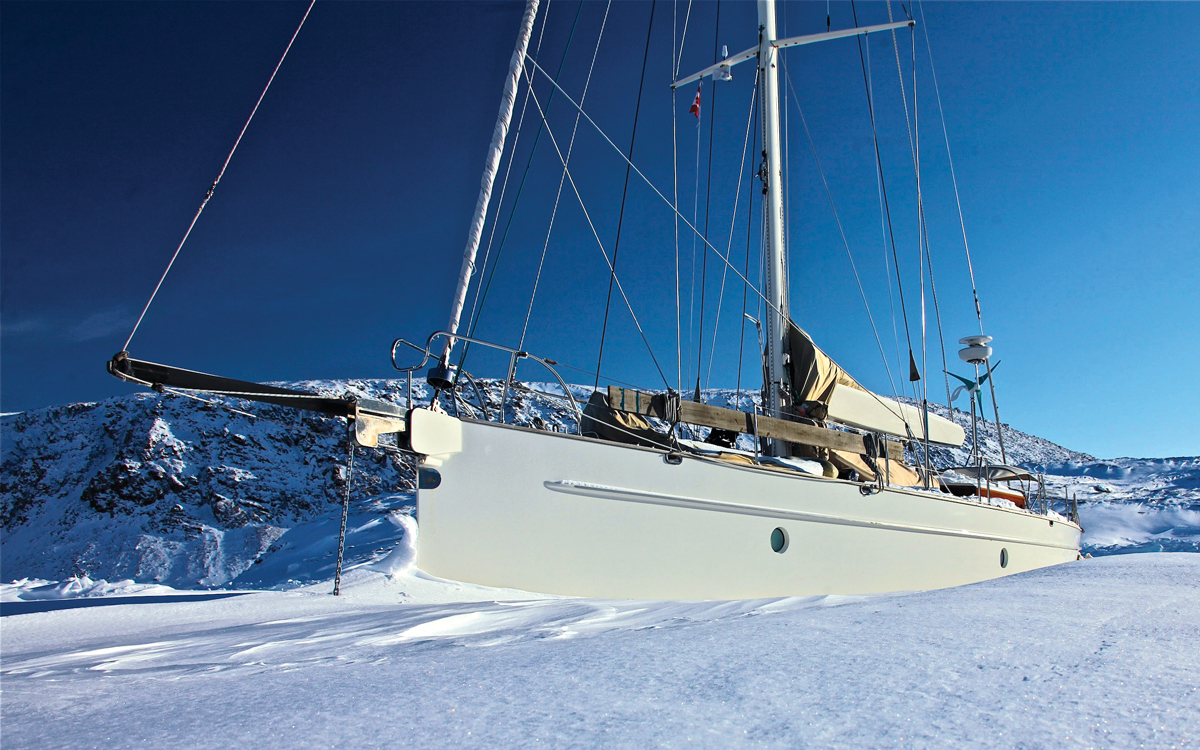
The Bestevaer range began when renowned naval architect Gerard Dijkstra chose to design his own personal yacht for liveaboard adventure cruising, a 53-footer. The concept drew plenty of interest from bluewater sailors wanting to make longer expeditions and Bestevaers are now available in a range of sizes, with the 56-footer proving a popular mid-range length.
The well-known Bestevaer 56 Tranquilo (pictured above) has a deep, secure cockpit, voluminous tanks (700lt water and over 1,100lt fuel) and a lifting keel plus water ballast, with classically styled teak clad decks and pilot house. Other owners have opted for functional bare aluminium hull and deck, some choose a doghouse and others a pilothouse.

Photo: Jean-Marie Liot
The Boreal 52 also offers Land Rover-esque practicality, with utilitarian bare aluminium hulls and a distinctive double-level doghouse/coachroof arrangement for added protection in all weathers. The cockpit is clean and uncluttered, thanks to the mainsheet position on top of the doghouse, although for visibility in close manoeuvring the helmsman will want to step up onto the aft deck.
Twin daggerboards, a lifting centreboard and long skeg on which she can settle make this a true go-anywhere expedition yacht. The metres of chain required for adventurous anchoring is stowed in a special locker by the mast to keep the weight central. Down below has been thought through with equally practical touches, including plenty of bracing points and lighting that switches on to red light first to protect your night vision.

Photo: Morris Adant / Garcia Yachts
Garcia Exploration 45
The Garcia Exploration 45 comes with real experience behind her – she was created in association with Jimmy Cornell, based on his many hundreds of thousands of miles of bluewater cruising, to go anywhere from high latitudes to the tropics.
Arguably less of a looker than the Bestevaer, the Garcia Exploration 45 features a rounded aluminium hull, centreboard with deep skeg and twin daggerboards. The considerable anchor chain weight has again been brought aft, this time via a special conduit to a watertight locker in front of the centreboard.
This is a yacht designed to be lived on for extended periods with ample storage, and panoramic portlights to give a near 360° view of whichever extraordinary landscape you are exploring. Safety features include a watertight companionway door to keep extreme weather out and through-hull fittings placed above the waterline. When former Vendée Globe skipper Pete Goss went cruising , this was the boat he chose to do it in.

Photo: svnaima.com
A truly well-proven expedition design, some 1,500 Ovnis have been built and many sailed to some of the most far-flung corners of the world. (Jimmy Cornell sailed his Aventura some 30,000 miles, including two Drake Passage crossings, one in 50 knots of wind).

Futuna Exploration 54
Another aluminium design with a swinging centreboard and a solid enclosed pilothouse with protected cockpit area. There’s a chunky bowsprit and substantial transom arch to house all manner of electronics and power generation.
Previous boats have been spec’d for North West Passage crossings with additional heating and engine power, although there’s a carbon rig option for those that want a touch of the black stuff. The tanks are capacious, with 1,000lt capability for both fresh water and fuel.
If you enjoyed this….
Yachting World is the world’s leading magazine for bluewater cruisers and offshore sailors. Every month we have inspirational adventures and practical features to help you realise your sailing dreams. Build your knowledge with a subscription delivered to your door. See our latest offers and save at least 30% off the cover price.

Editor’s Choice: 18 Bluewater Sailboats We Love
Advantages of bluewater sailboats, factors to consider when buying a blue water sailboat, allures 51.9, contest 55cs, discovery revelation 480, grand soleil 42 lc, hallberg-rassy 48mk ii, island packet 349, j/boats j/45, najad 395 cc, outbound 56.
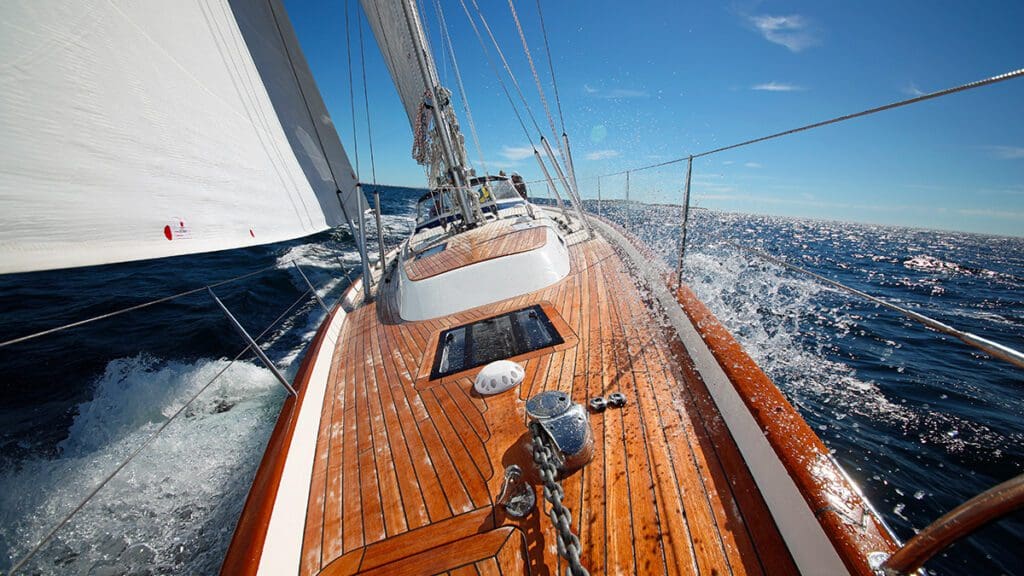
Looking to sail the open seas? Bluewater sailboats are your answer. With their sturdy construction and ability to handle rough conditions, these boats are designed for serious offshore sailing adventures. In this comprehensive guide, we will delve into the world of blue water sailboats and provide you with everything you need to know. From their unique features to their advantages and considerations, we will explore it all.
Bluewater sailboats are known for their strength and durability. Built to withstand the challenging conditions of ocean crossings, these boats offer stability and safety on long voyages. Whether you’re planning a solo trip or setting off with a crew, a blue water sailboat is an excellent option to explore the depths.
We will discuss the key characteristics that make blue water sailboats stand out, such as their hull design, rigging, and navigation systems. Additionally, we’ll explore the various types and sizes available to help you find the perfect fit for your sailing aspirations.
So, if you’ve ever dreamed of embarking on a thrilling ocean adventure, join us as we navigate the world of bluewater sailboats and uncover everything you need to know.
Bluewater sailboats are designed to withstand the demanding conditions encountered during long ocean voyages. They possess several key characteristics that set them apart from other types of sailboats.
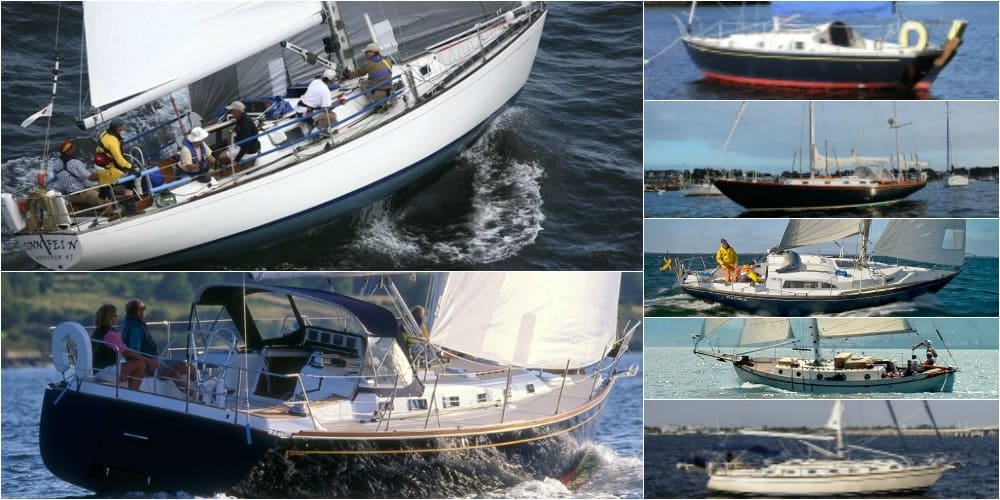
1. Sturdy Construction
Bluewater sailboats are built with robust materials and construction techniques to ensure their strength and durability. They feature reinforced hulls made of fiberglass, aluminum, or steel, which can withstand the impact of large waves and adverse weather conditions. These boats are designed to handle the constant stresses of offshore sailing without compromising their structural integrity.
2. Seaworthiness
One of the defining characteristics of bluewater sailboats is their seaworthiness. They are designed to handle rough seas and strong winds, providing a stable and comfortable ride even in challenging conditions. The shape of their hulls, with a deep V or modified full-keel design, allows them to cut through waves and maintain stability, minimizing the rolling motion commonly experienced on other types of sailboats.
3. Self-Sustainability
Bluewater sailboats are equipped with systems that enable self-sustainability during long voyages. They typically have large water and fuel tanks, allowing sailors to carry ample supplies for extended periods at sea. In addition, these boats often come equipped with renewable energy sources such as solar panels or wind turbines, reducing the reliance on external power sources.
Bluewater sailboats offer numerous advantages for sailors looking to embark on offshore adventures. Here are some of the key benefits of choosing a blue water sailboat for your next sailing journey.
1. Safety and Stability
When sailing across vast oceans, safety is paramount. Bluewater sailboats provide a high level of safety and stability, thanks to their sturdy construction and seaworthiness. These boats are designed to handle adverse weather conditions and rough seas, ensuring the safety of the crew and the vessel. The robust hulls and well-balanced designs make them less prone to capsizing or taking on water, providing peace of mind during long voyages.
2. Long-Distance Capability
Bluewater sailboats are specifically designed for long-distance sailing. They have the capacity to carry ample supplies, including food, water, and fuel, allowing sailors to embark on extended journeys without the need for frequent resupply stops. With their self-sustainability features and efficient hull designs, these boats can cover long distances efficiently and comfortably.
3. Comfort and Liveability
Living aboard a bluewater sailboat for an extended period requires comfort and practicality. These boats are designed with spacious interiors, allowing for comfortable living quarters during long voyages. They often feature multiple cabins, a well-equipped galley, and ample storage space for provisions and personal belongings. The layout and design of blue water sailboats prioritize functionality and convenience, ensuring a comfortable living experience even in the middle of the ocean.
And now… it’s time to discover together our selection of 18 Bluewater sailboats we love!
The Allures 51.9 innovates with its full-beam aft owner’s cabin. This model disrupts the codes of the yard also outside with its cockpit of 6 meters long with sunbath and swim platform for comfort; the navigation space can be protected by a hardtop to navigate in any security. The boat has a length of 51.9 feet (15.8 meters) and a beam (width) of 15.4 feet (4.7 meters). It is equipped with a fixed keel and a composite hull, which provides good stability and seaworthiness. The Allures 51.9 is available in a variety of configurations, including a three-cabin layout with a spacious owner’s cabin and two guest cabins, or a two-cabin layout with a larger owner’s cabin and a smaller guest cabin. It is also equipped with a well-equipped galley, a large saloon, and a navigation station. Allures official website .
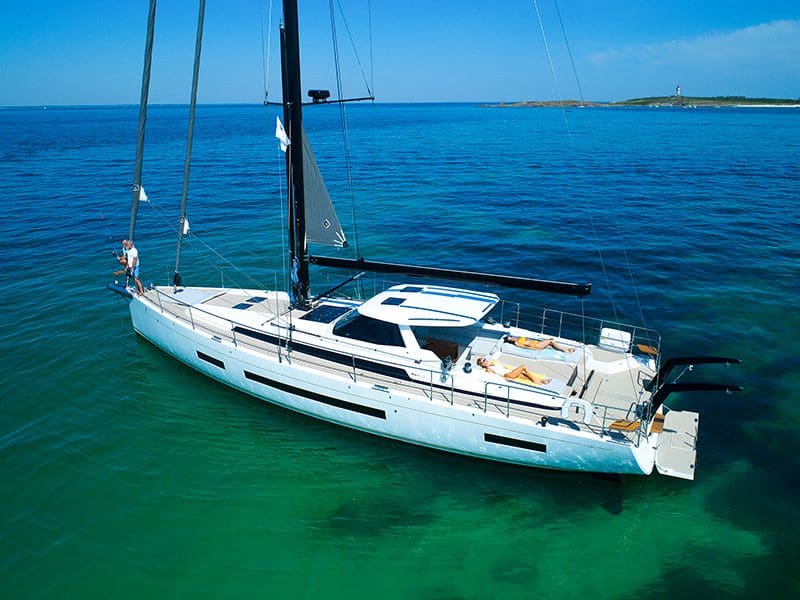
In a dynamic evolution and complementary to their range, Amel launched a larger model, with a higher specification and built with attention to details. Riding on the success of the Amel 50 , the Amel 60 is an enhanced version of the new Amel design . The brand’s fundamental characteristics are well represented in this large yacht, with an additional 10 feet increasing her volume as well as her interior and exterior living spaces, while still ensuring ease of use for a small crew.
Signed Berret-Racoupeau, the generous volumes of this large yacht have been designed to allow owners and their guests to fully enjoy life on board, while preserving everyone’s privacy: a large living space in the saloon, an ultra-equipped high-end galley three cabins each with a bathroom, an even larger protected cockpit, opening onto sunbathing areas ideal for relaxation.
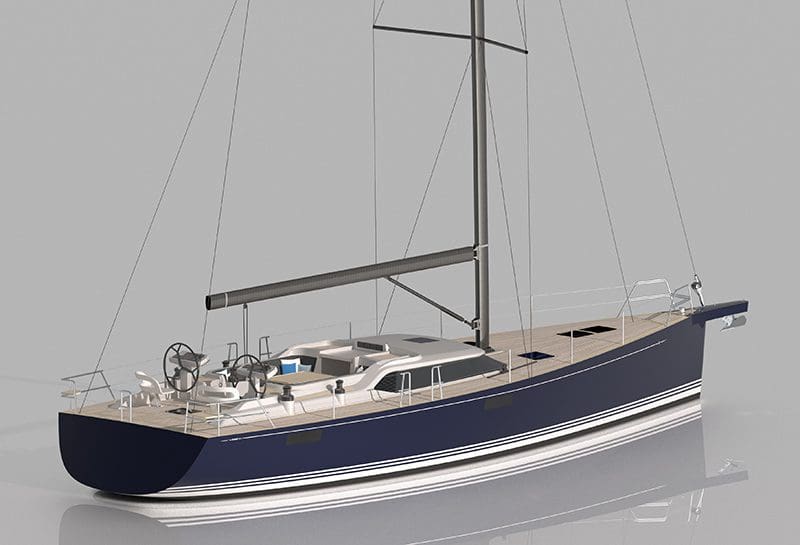
The Dutch specialist in semi-custom constructions Contest Yachts presented the brand new 17-metre Contest 55CS at Boot Dusseldorf 2020. Don’t call it “simply” a bluewater yacht. The stunning lines both above and below water from star designers Judel/Vrolijk shall ensure a real sporty character. A newly conceived interior styling now features an even bigger flowing corner radius to the exquisitely finished timber work. There are also now more optional hull windows in up to four stations along the yacht’s length.
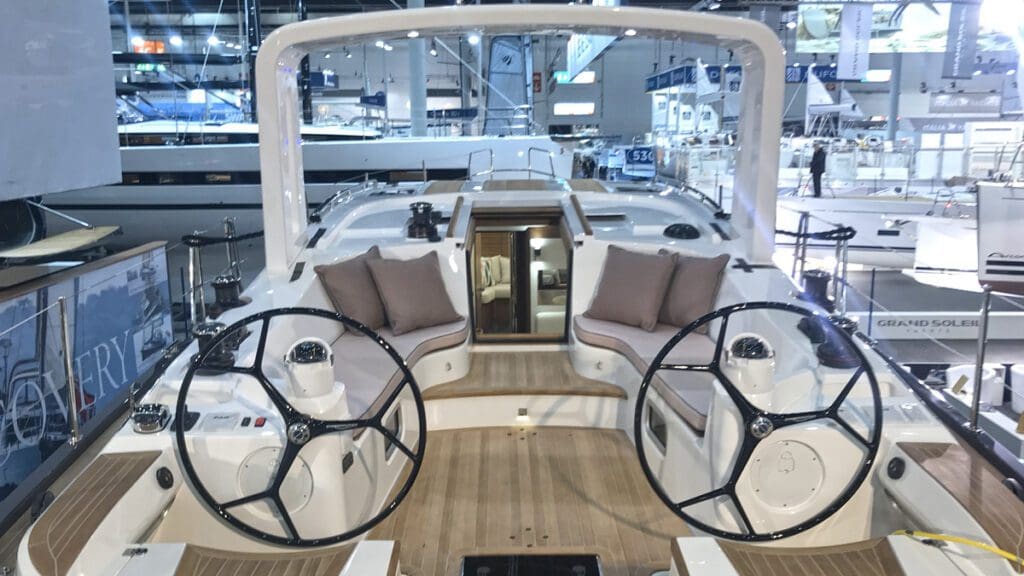
Discovery Yachts presented the new Revelation 480 at Boot Dusseldorf 2020 . This is the first model of the new Revelation line and differs from the Southerly line for the fixed keel and the lowered saloon. Yes, the Revelation 480 is a lowered saloon boat based on the well-known Southerly 480. The Revelation 480 combines bluewater capability with a low, sleek coachroof that contributes to an interesting aesthetic. Down below, the single level interior is extremely light and exquisitely furnished.
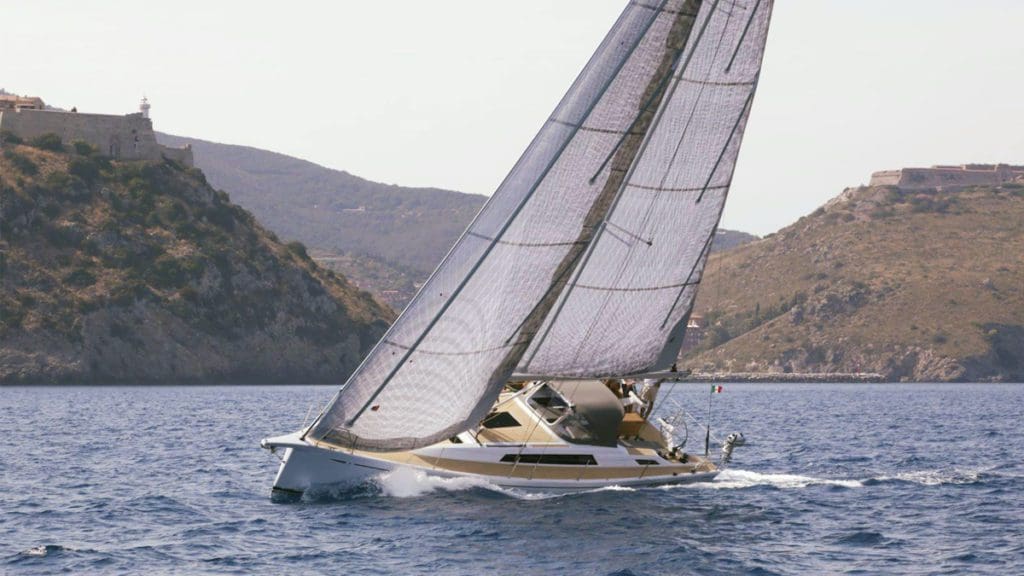
The Grand Soleil 42 LC is Cantiere del Pardo ’s latest entry model of the bluewater line. Comfort and sailing autonomy are the main features of this 12-meter, designed by Marco Lostuzzi together with Nauta Design and Cantiere del Pardo’s Technical Office.
The 42 LC is available in two versions; standard or sport. The former is equipped with aft benches, and a carbon arch over the cockpit, designed to keep this area free of the mainsheet traveller. The GS 42 LC’s hull guarantees great stability thanks to greater hull volume. The well-proportioned sail plan optimizes the high-performance sailing standards. As with the rest of the Long Cruise range, the Grand Soleil 42 LC is designed to provide greater and more luxurious comfort on board.
The interior layout is available with either two or three cabins, to meet the client’s needs. Both versions include two heads with a shower. In the saloon, a three-seater sofa is found on the starboard side, while the central seat can be transformed into a chart table.
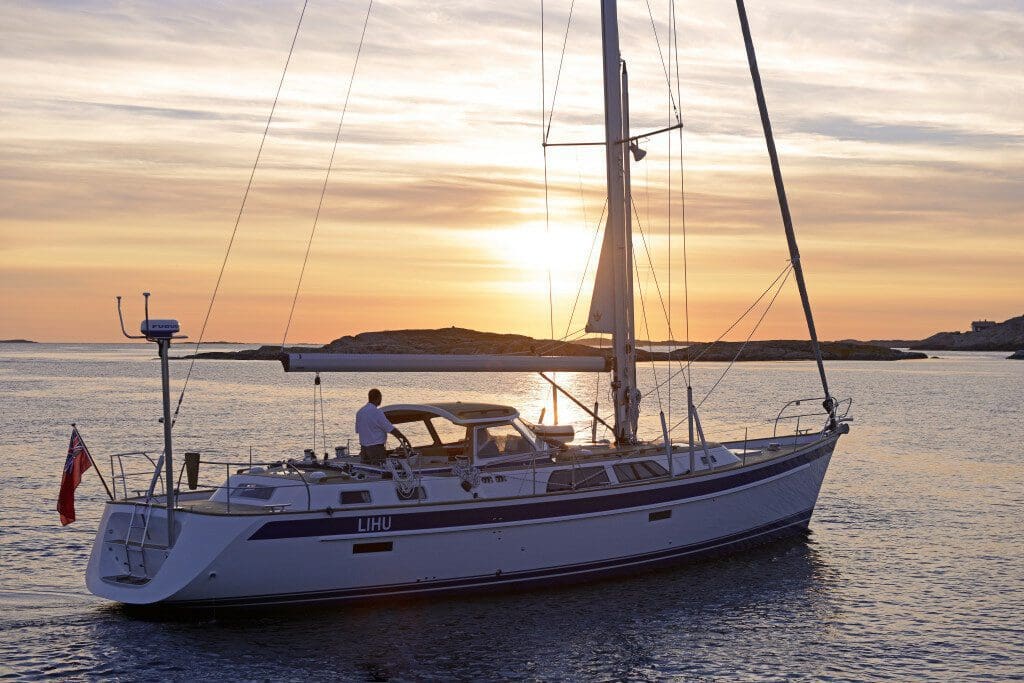
The Hallberg-Rassy 48 MK II is a true bluewater cruiser that offers more natural light, more comfort and more elegance than ever before. With three double cabins and a vast saloon, she offers great space for modern comfort aids. Known far and wide for sturdy construction, superb craftsmanship and signature seaworthiness, Hallberg-Rassy boats are globally respected for their elegant lines and spirited performance.
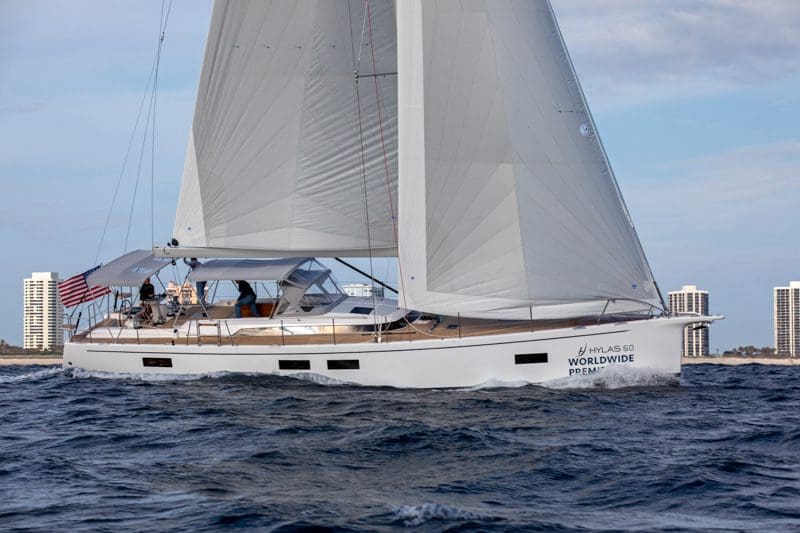
Hylas Yachts has collaborated with German Frers for over 40 years and built a reputation for yachts that combine ocean sailing capability, classic lines and exquisitely finished interiors. Now the company is staking out new territory with the H60. Still ocean capable, still with an exquisite interior but also embracing some of the contemporary demands of today’s cruising sailors.
Longtime Hylas fans will not be disappointed by her performance. Built using the most advanced construction technologies, the H60 has been designed to excel in all conditions with excellent seakeeping ability. A plumb bow and broad transom make the most of her waterline length underway, providing speed with optimal comfort.
The builder partnered with Milan-based firm Hot Lab , known for their elegant designs in the superyacht world, to offer interiors that immediately set the new Hylas on a new level.
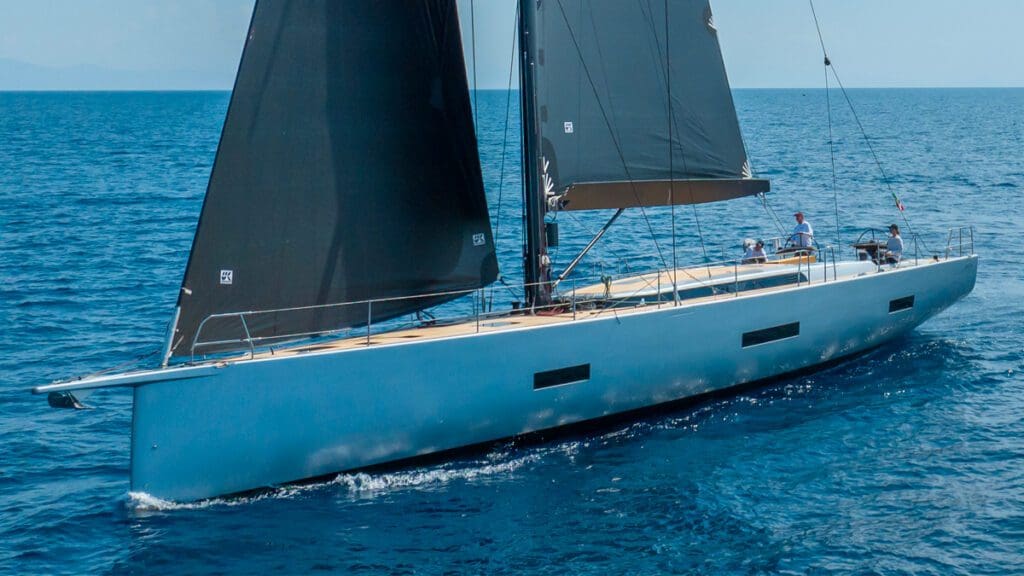
The project of the ICE 70 by ICE Yachts has been realized using the most advanced modeling and analysis software available today. “ Thanks to the new virtual reality ‘tools’ ,” explains Felci Yacht Design , “ we have been able to make the owner and the shipyard participant of many geometric and stylistic choices. It is a yacht with high technological potential, starting from the design of the hull and the appendices “. With this sporty bluewater sailboat, the Italian yard wanted to create a technologically avant-garde boat with large, comfortable indoor and outdoor spaces, which is easy to sail and entirely safe at sea. Like all ICE Yachts models, the ICE 70 is a semi-custom product with which the owner has many possibilities for customization and equipment. ICE Yachts official website

With this model, iconic Island Packet has returned to the Solent-style rig as standard, featuring a mainsail with a working jib and an optional lightweight 170% reacher or asymmetrical that mounts on the integral bow platform and furled with Harken systems. The working jib is fitted with a Hoyt Boom that is self-tending and improves performance with its close sheeting and self-vanging feature, while the large optional reacher or asymmetrical boost performance in light air or when off the wind.
The fully battened mainsail is equipped with a low friction Battcar system and drops easily into a stack pack with an integral cover and lazy jack system. This rigging offers ease of use and versatility in the varied wind or sea conditions and increased speed and maneuverability.
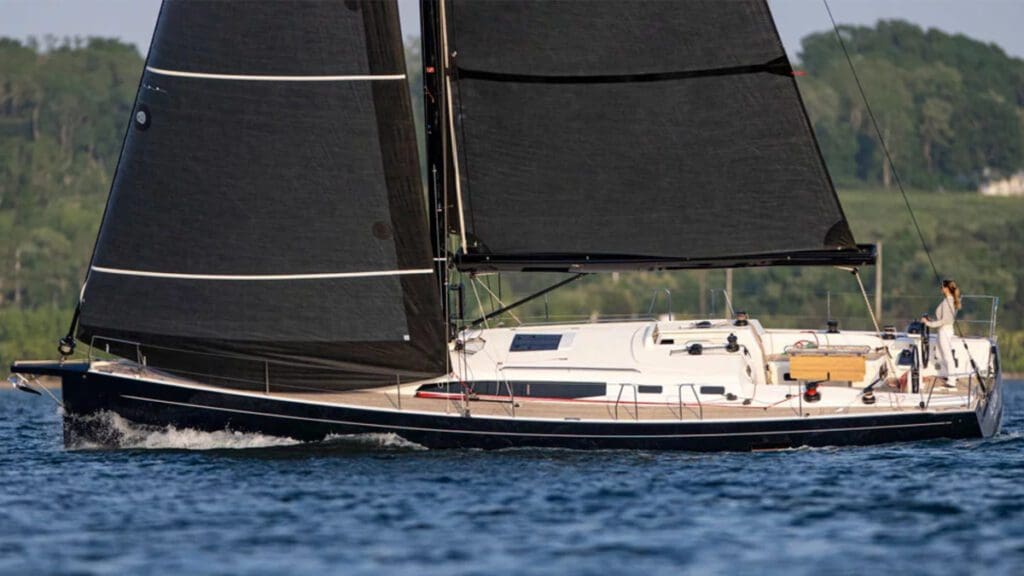
The J/Boats J/45, is a true bluewater sailing yacht, designed and built for the sea by life-long sailors. The J/Boats and J/Composites teams have collaborated to create a special design for discerning sailors seeking an exceptional sailing experience. The J/45 can be sailed solo, cruised by 2-3 couples or large family, and pleasure sailed or raced with room for the whole crew. This is an investment-grade sailboat that won’t require a professional crew to sail, handle or maintain. J/Boats official website
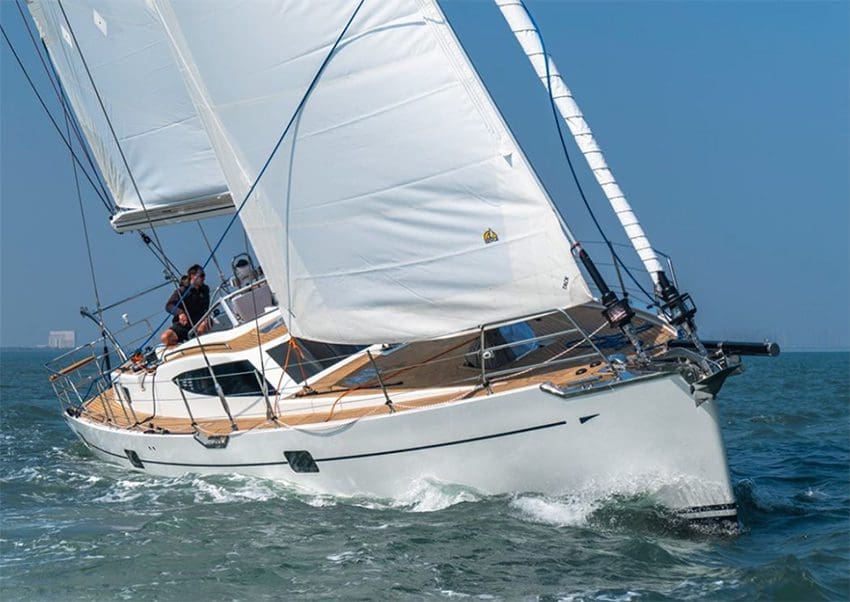
The Kraken 50 is designed to be the short-handed bluewater cruising yacht. Due to her steady motion and stability, her crew will be equally comfortable at sea or in the anchorage, and special consideration has been given in the K50 layouts above and below deck to allow for short-handed ocean passage making. The Kraken 50 features the renowned integral Zero Keel and fully skegged rudder.
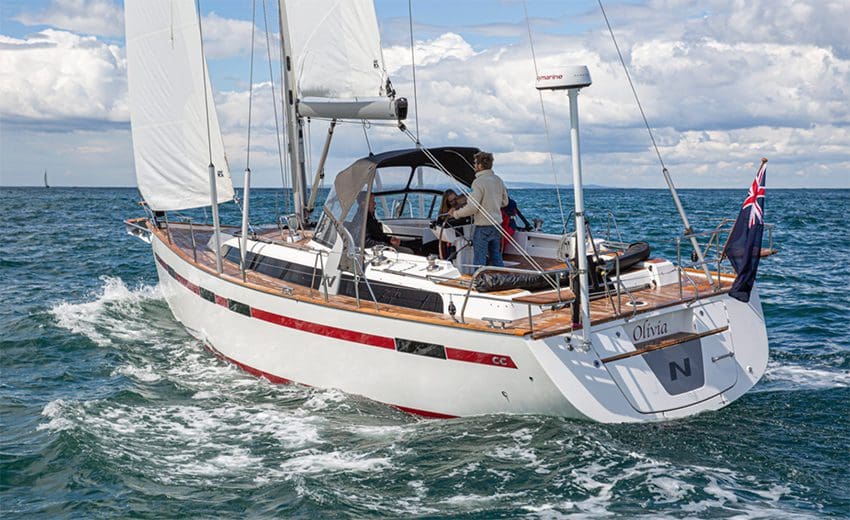
N395 CC (centre cockpit) is part of the all-new Najad 395 range, designed in a joint venture by Najad, Farr Yacht Design, and Ken Freivokh Design – superyacht stylist, architects, and interior designers. The N395 CC is characterized by a well-protected large cockpit located close to the center of gravity. It has a well-designed interior and a very comprehensive options list that includes all equipment necessary to tailor the yacht to any individual needs. This model is available in two or three cabin layouts with one or two large heads.

Welcome aboard the newest addition to Outbound’s impressive line of offshore passage makers. The new Outbound 56, built from German Frers timeless and proven design continues to fulfill our single mission of building great offshore yachts. Fast, accommodating and gorgeous, the 56 will take you anywhere your heart desires in style and comfort.
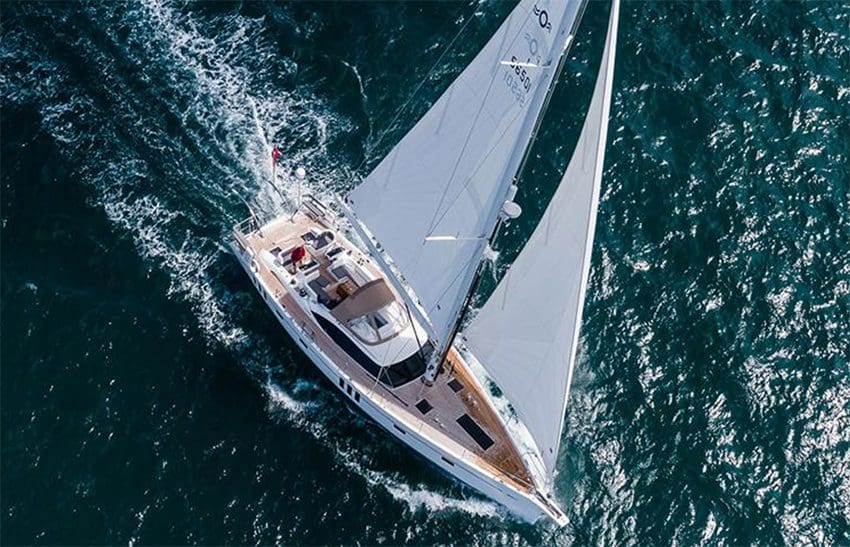
The entry level yacht for the ‘G6’ range of seven models up to the Flagship Oyster 118. Using the latest generation of Oyster hull shapes, developed with Humphreys Yacht Design, the Oyster 565 is designed for family sailing without professional crew.
A generous sail locker and lazarette, headroom and bunk lengths to match the larger Oyster Superyachts, the 565 can be configured with many different cabin layouts – and for the first time in Oyster Yachts – can have the master cabin forward and a dinghy garage in the transom.
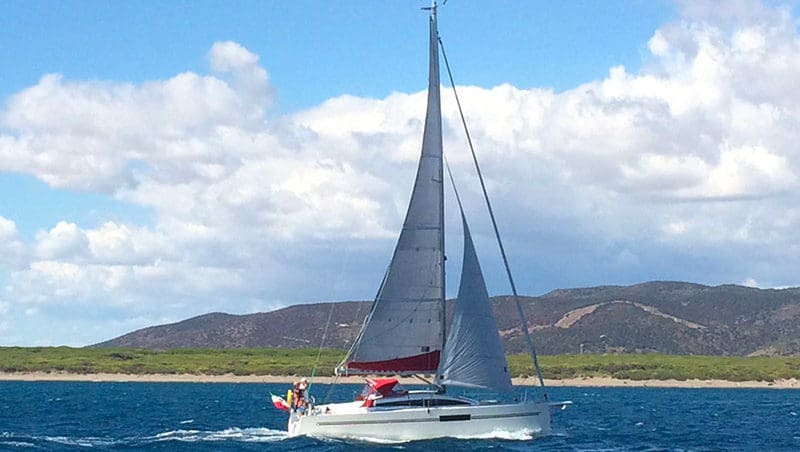
The Brittany based yard is well known not only among ocean sailors but also to those who love short-handed sailing and are looking for seaworthy and easily driven bluewater sailboats, both safe and comfortable. This last aspect is where Fora Marine has made great progress in the last few years, shedding some of the spartan image that characterized their products for many years.
What has not changed, and what is still the RM range’s defining characteristic, is the twin-chined hull, made of Okumé plywood impregnated with epoxy resin (the deck is in fiberglass sandwich). Below the hull, the yard offers two options, a single deep keel or double shoal draft keels. The RM are designed by Marc Lombard, probably one of the architects most able to transform the fashionable chine into an important element in cruising design. A chined hull, when properly drawn, gives both better hull shape and interior volumes. ( Read our test )
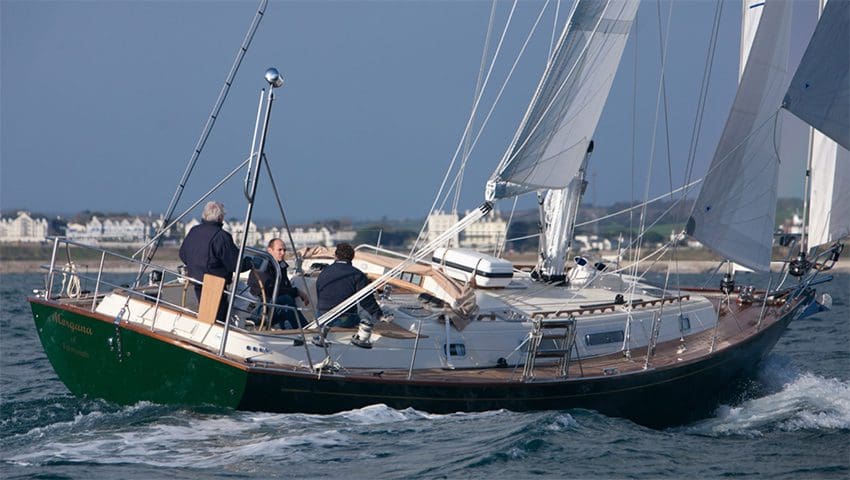
The Rustler 42 is a classic looking yacht which combines style that is traditional yet modern. Her cruising layout results in a live aboard yacht that has stability and elegance with the same unique sea-kindly characteristics as the Rustler 36. Below the waterline, she looks conservative with a deep canoe body, long fin keel and a big skeg hung rudder.
Below the decks, this yacht has a spacious open plan saloon. The large, finished saloon table can comfortably seat eight. The aft cabin has standing headroom, a full-width double berth and plenty of storage within lockers and a vanity unit with seat. The aft head incorporates a shower unit and a ‘wet lilies’ locker. At the forepeak the grand master cabin has a 6 ft 6 in double V berth.
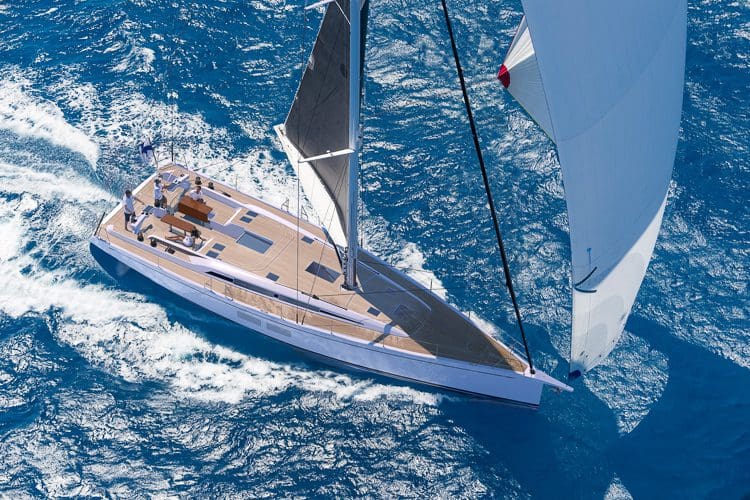
Signed by German Frers , the Swan 58 needs to combine the spaces of bluewater sailboats with a fast cruiser performances. Key details include a deck featuring soft and rounded shapes, a new cockpit design, a redefined coach-roof style and large swimming platform. The concept is easy: to give the maximum comfort and liveability at rest, together with maximum efficiency for short handed sailing, without losing the capability to race with a full crew.
The interiors of the new Swan 58 , which is fitted with European oak, have been conceived as a combination between luxury and comfortable living spaces, storage and volumes for systems and safety features; we find here a large saloon, a galley with a 360 degree layout and three heads. Various interior styling layouts are available varying woods and materials.
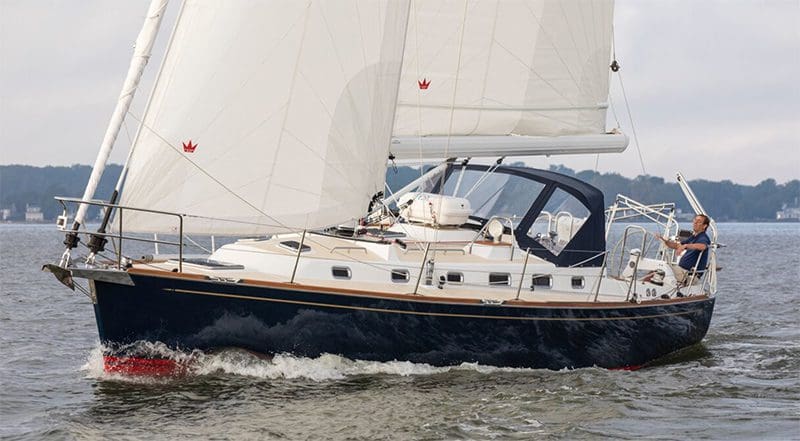
Designed by Tartan naval architect Tim Jackett, the 395 comes out of the Tartan factory in Fairport Harbor and is the perfect example of bluewater sailboats. Her hull shape is an evolution of tried and true concepts proven to deliver great stability and high interior volume while maintaining comforting manners throughout a wide range of sailing conditions. On deck Tartan 395 sports hallmark Tartan design elements such as a traditional cabin house fitted with functional polished stainless steel rectangular portholes.
Like her smaller sister 345, 395’s handcrafted interior is built in maple as standard, with cherry a no-charge option. The lighter maple opens up her interior in ways the darker cherry simply cannot.
Comfort Meets Endurance: The Mishi 88’s Test of Sea-Strength
Southern wind 108 gelliceaux wins the international superyacht society award 2024, aquarius ii: royal huisman’s latest superyacht begins final outfitting, engineering excellence: key features of the pelagic 77 ‘amundsen’, live your passion, subscribe to our mailing list.
7 Legendary Solo Bluewater Sailboats Worth Considering
When setting out to explore the open seas solo, you'll have to choose the right bluewater sailboat from so very many available options. The perfect boat for sailing single-handed is one that's not only safe and seaworthy, but also easy to handle on your own. In this article, we've handpicked the top 7 legendary solo bluewater sailboats worth considering for their excellent track records.
The most legendary solo bluewater sailboats are the Contessa 32, Westsail 32, Hallberg-Rassy 42F, Pacific Seacraft 37, Island Packet 38, Tayana 42, and Amel 54. These boats have it all: from robust designs to a world-renowned reputation for performance and reliability. They are known for their seaworthiness, durability, and comfort.
We understand the importance of balancing comfort and performance when spending prolonged periods at sea. Each of these sailboats has been proven to provide a harmonious blend of these attributes. Let's get to know them more below.
- Solo bluewater sailboats are designed to be sailed by a single person, making them ideal for solo circumnavigation or long-distance cruising.
- You can get the Contessa 32 and Westsail 32 for as little as $30,000.
- The maintenance and repair costs of the seven boats range from $5,000 to $50,000 per year.
- Marina fees and insurance can range from $5,000 to $20,000 per year.
- Factor in upgrades and equipment costs that can reach up to $100,000.
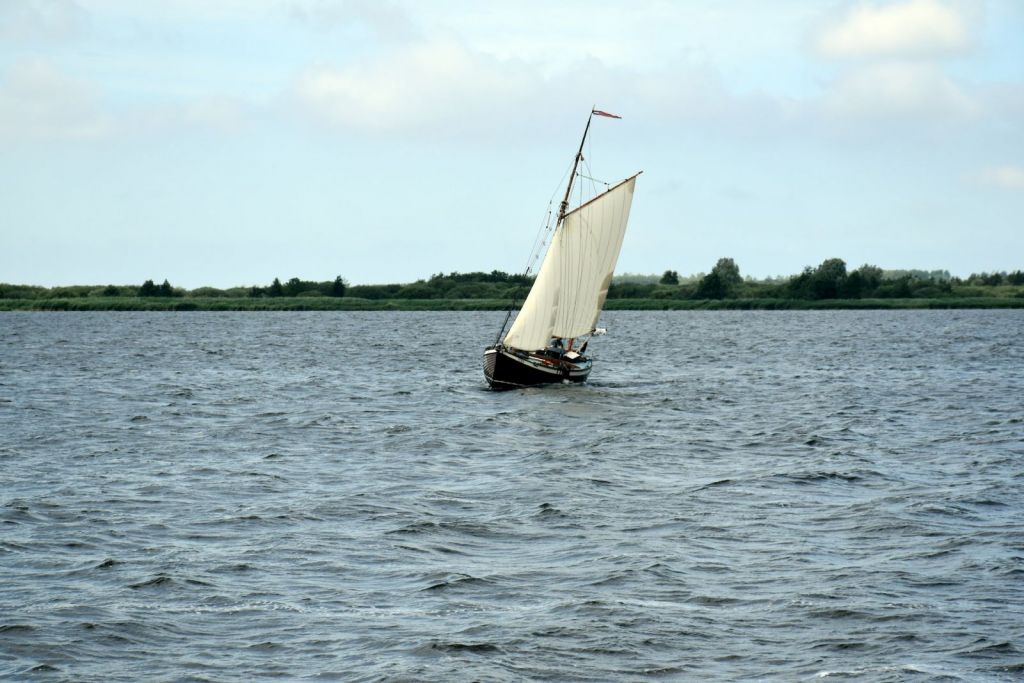
On this page:
The best solo bluewater sailboats, what makes a good solo bluewater sailboat, cost considerations when choosing a sailboat, maintaining your bluewater sailboat.
| Initial Purchase Price | Maintenance and Repairs | Marina Fees and Insurance | Upgrades and Equipment | |
|---|---|---|---|---|
| $30,000 to $60,000 | $5,000 to $10,000 per year | $5,000 per year | $5,000 to $15,000 | |
| $30,000 to $80,000 | $5,000 to $10,000 per year | $5,000 per year | $5,000 to $20,000 | |
| $200,000 to $400,000 | $10,000 to $20,000 per year | $10,000 per year | $20,000 to $50,000 | |
| $100,000 to $200,000 | $10,000 to $20,000 per year | $10,000 per year | $20,000 to $40,000 | |
| $100,000 to $200,000 | $10,000 to $20,000 per year | $10,000 per year | $20,000 to $40,000 | |
| $100,000 to $250,000 | $10,000 to $20,000 per year | $10,000 per year | $20,000 to $50,000 | |
| $500,000 to $1,000,000 | $20,000 to $50,000 per year | $20,000 per year | $50,000 to $100,000 |
Contessa 32 is a classic, compact, and seaworthy sailboat
Contessa 32's sturdy construction and excellent sailing performance have earned it a legendary reputation among sailors. With a well-designed interior layout, it has space for living aboard during your solo adventures. The Contessa 32 is a classic bluewater sailboat designed by David Sadler in the 1970s. It is known for its excellent balance, seaworthiness, and speed. It has a full keel, moderate displacement, and a classic design that has stood the test of time.
Westsail 32 is known for its rugged construction
The Westsail 32 gained fame as an affordable, rugged, and capable long-distance cruiser. Its full keel and sturdy hull ensure a comfortable ride in rough seas. The practical, function-driven interior makes it easy for solo sailors to maintain and navigate the vessel while providing essential amenities for an extended voyage.
Westsail 32 is another classic bluewater sailboat that was designed by William Crealock in the 1970s. It is known for its rugged construction, spacious interior, and excellent performance in heavy weather. The Westsail 32 has a full keel, heavy displacement, and a classic double-ender design.
Hallberg-Rassy 42F is known for its top-notch craftsmanship
The Hallberg-Rassy 42F is another superb choice for single-handed bluewater sailing. This Swedish-built yacht is well-renowned for its top-notch craftsmanship, stability, and comfort. It offers a spacious, well-lit interior, ensuring you'll enjoy your time below deck while cruising the open seas.
Hallberg-Rassy 42F is a modern bluewater sailboat designed by German Frers in the 1990s. It is known for its luxurious interior, excellent performance, and high-quality construction. The Hallberg-Rassy 42F has a fin keel, a spade rudder, and a modern design that combines comfort and performance.
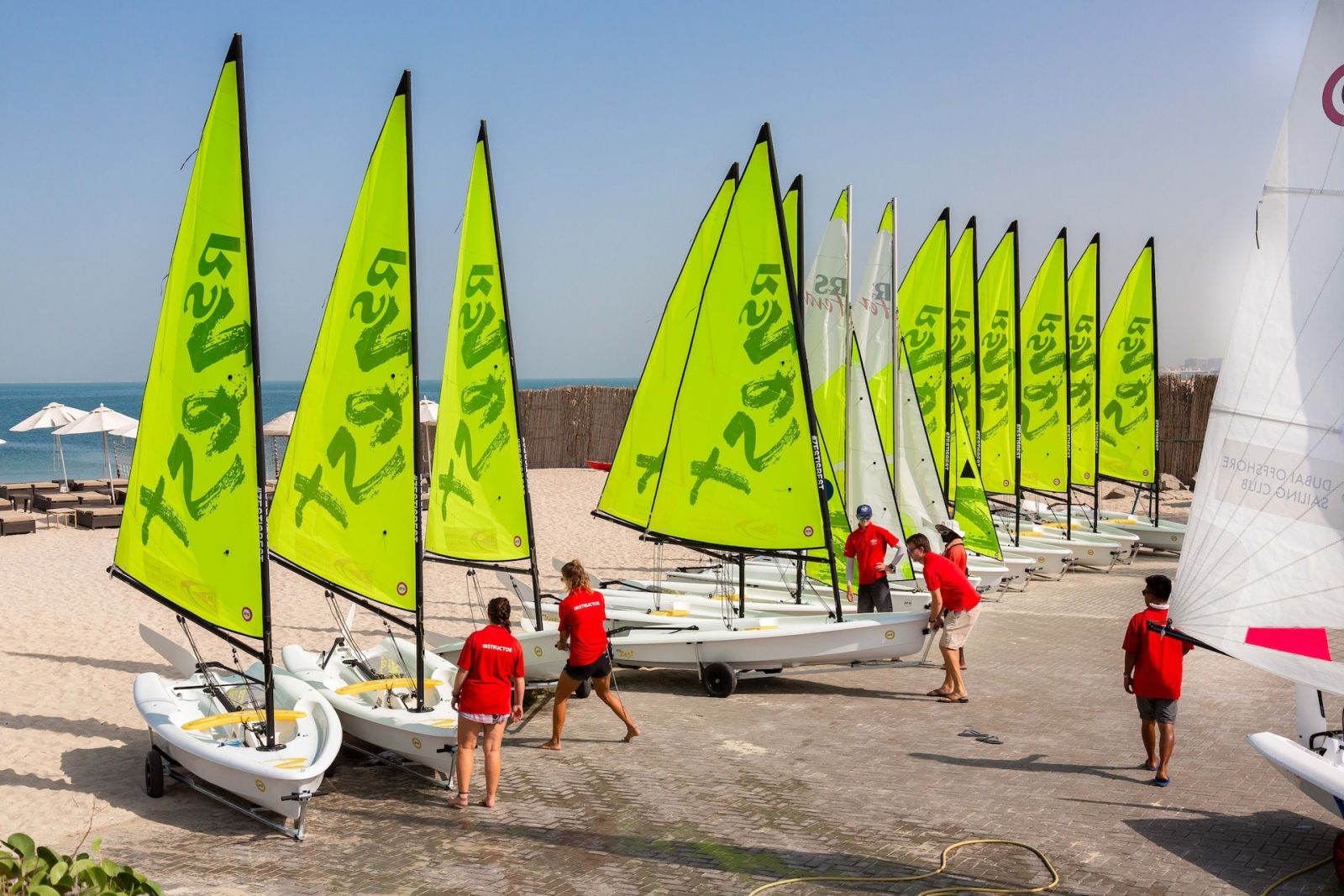
Pacific Seacraft 37 is designed for serious cruising
Pacific Seacraft 37 is a sturdy and reliable boat for solo sailors. Its moderate displacement and full keel provide excellent stability, while the well-thought-out interior layout includes abundant storage and comfortable living quarters. Its reputation as a proven bluewater cruiser makes it a top choice for solo sailors. The Pacific Seacraft 37 is another classic bluewater sailboat designed by Bill Crealock in the 1970s. It is known for its excellent balance, seaworthiness, and comfort.
Island Packet 38 is known for its spacious interior
Island Packet 38 is a popular choice among solo cruisers, thanks to its stable full keel design and living space. Its build quality, comfort, and performance make it well-suited for long-distance sailing. The spacious interior and practical layout ensure you have everything needed for a successful solo journey. Island Packet 38 is a modern bluewater sailboat designed by Bob Johnson in the 1990s. It 38 has a full keel, moderate displacement, and a modern design that combines comfort and performance.
Aside from bluewater sailing , there are other types of sailing discussed in this article.
Tayana 42 is known for its excellent balance, seaworthiness, and comfort
Tayana 42 is a comfortable, sea-kindly sailboat, ideal for single-handed offshore cruising. Its balanced performance, easy handling, and well-equipped interior ensure a safe and comfortable journey. It is well-regarded among sailors for its proven bluewater capabilities and timeless styling. The Tayana 42 is another classic bluewater sailboat designed by Bob Perry in the 1970s. It has a full keel, heavy displacement, and a classic design that has stood the test of time.
The Amel 54 is known for its luxury and exceptional build quality
This French-built vessel offers a spacious and comfortable interior with top-of-the-line amenities, making it an excellent option for solo sailors seeking a bluewater cruiser to explore the world in style and comfort. Its easy-to-handle design with advanced sailing systems allows you to sail solo with confidence and ease. The system includes electric winches, furling sails, and a self-tacking jib, which make it easy to handle the boat in all conditions.
To learn more about bluewater sailing , here's our comprehensive article on it.

These factors will ensure not only your safety but also your comfort and ease during your sailing adventure.
Size and stability of a solo sailboat
A boat with a wide beam and short waterline provides more stability, making it easier for you to handle the vessel on your own. Some popular sailboat models known for their size and stability include the Westsail 32 and the Hunter Channel 31.
A good solo bluewater sailboat should be large enough to provide adequate storage space for supplies and equipment, while also being stable enough to handle rough seas and high winds. It should also have a well-designed hull shape that provides good stability and balance, and a keel that provides good tracking and prevents the boat from capsizing.
Ease of use and maneuverability of any solo sailboat
Features like roller furling and an electric windlass can make handling the sails and anchor much more straightforward. Also, hydraulic bow/stern thrusters with remotes can help you maneuver your boat easily and safely. Make sure to look for these features when choosing your bluewater sailboat.
A good solo bluewater sailboat should be easy to handle and operate by a single person. It should have a sail plan that is easy to adjust and control, and a steering system that is responsive and easy to use. It should also have a well-designed cockpit that provides good visibility and protection from the elements.
Durability and seaworthiness for long-term safety
A well-built sailboat with a history of proven offshore performance should be at the top of your list. Some of the best and most famous bluewater sailboats include the Alberg 30 and Hanse 371.
A good solo bluewater sailboat should be built to withstand the rigors of extended ocean voyages. It should have a strong, well-built hull that is capable of withstanding heavy seas and high winds. It should also have a well-designed rigging system that is strong and durable, and a keel that is designed to provide good stability and balance.
To learn more about the best keel design for bluewater sailing , here's our article on it.
Comfort and livability of a solo sailboat
Consider the layout and features of the boat, ensuring that it has a comfortable sleeping area, a well-equipped galley, and ample storage space. A good example is the Valiant 40, known for its excellent layout and seaworthiness.
A good solo bluewater sailboat should be comfortable and livable for extended periods of time. It should have a well-designed interior that provides adequate storage space, comfortable sleeping quarters, and a functional galley and head. It should also have good ventilation and lighting, and be well-insulated to provide protection from the elements.
Affordability and availability determine the sailboat's practicality
Set a budget and research suitable sailboats within that price range. Some budget-friendly options include the J/109 and Westsail 32. A good solo bluewater sailboat should be reasonably priced and readily available. It should be affordable for most sailors who are interested in long-distance cruising, and should be available for purchase or charter in most parts of the world.
If you're looking for bluewater sailboats under 40 feet , here's our article where we picked the top 13 most famous ones.
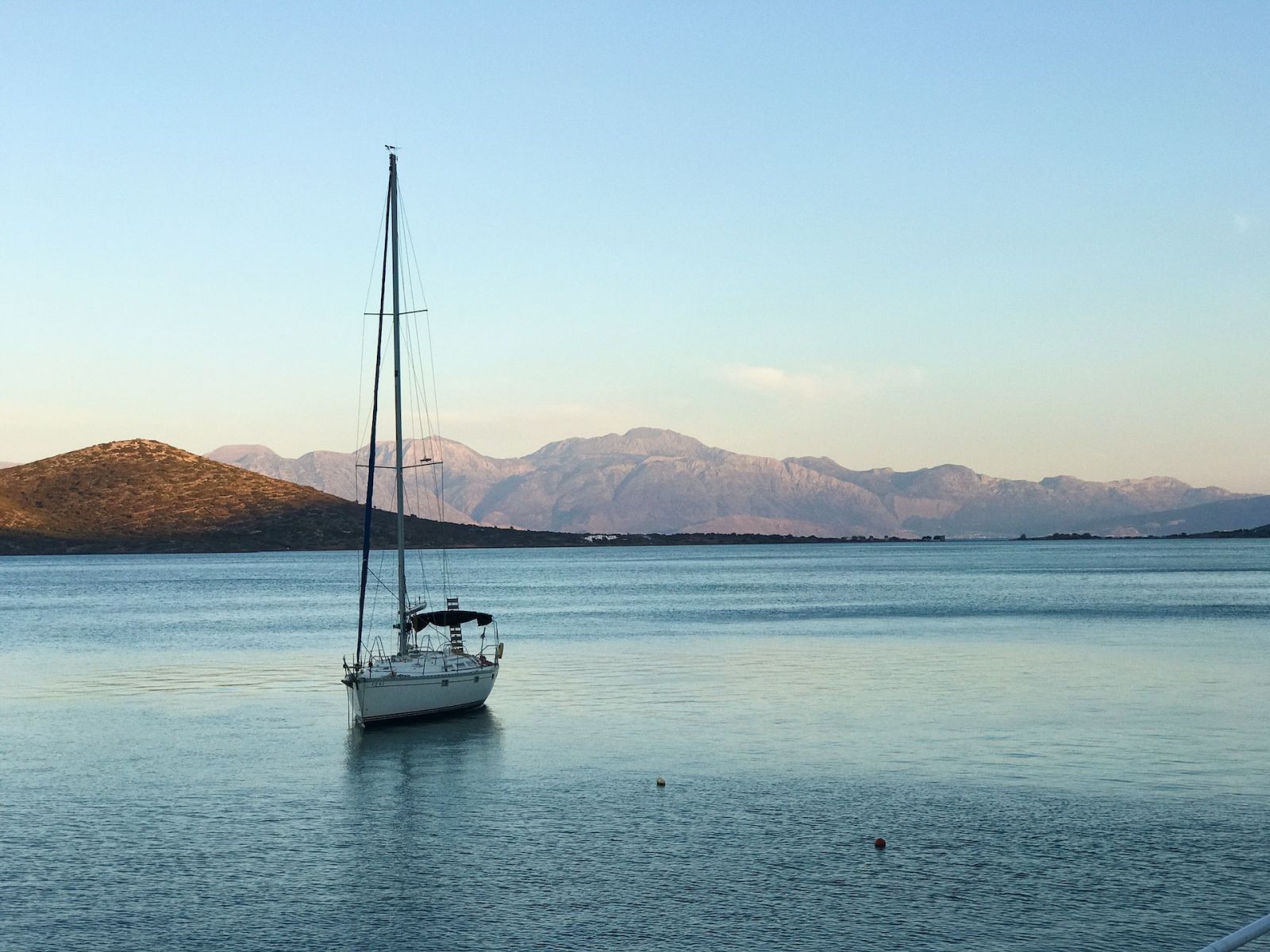
You'll be faced with a range of solo bluewater sailboat options, from budget-friendly to luxury models. Let's explore some factors you should keep in mind to make the best decision for your needs and budget.
Initial purchase price : This is often the first thing people think of when it comes to the cost of a sailboat. There's a wide range in prices, depending on factors like age, size, and brand. For example, a used Alberg 30 might cost between $10,000 and $15,000, while a new Amel 54 could be in the range of hundreds of thousands of dollars. It's important to find a balance between quality and affordability that suits your needs and financial capabilities.
Maintenance and repairs : Owning a sailboat comes with ongoing expenses to keep it in good sailing condition. Regular maintenance tasks like painting, replacing worn rigging, and inspecting safety equipment can add up over time. Be prepared to allocate a portion of your budget for these essential tasks, as neglecting them could lead to more expensive repairs down the line.
Marina fees and insurance : Depending on where you plan to keep your boat, you may incur costs for marina or dockage fees. Additionally, securing insurance coverage for your sailboat is a must to protect your investment. Both of these costs can vary widely, so make sure you factor them into your overall budget.
Upgrades and equipment : To ensure your sailboat is well-suited for solo bluewater sailing, you might need to invest in upgrades to improve its safety and performance. For instance, you may want to add a roller furling system, wind vane, or more advanced navigation equipment. These enhancements can amount to a significant investment, so it's wise to plan financially for any desired upgrades.
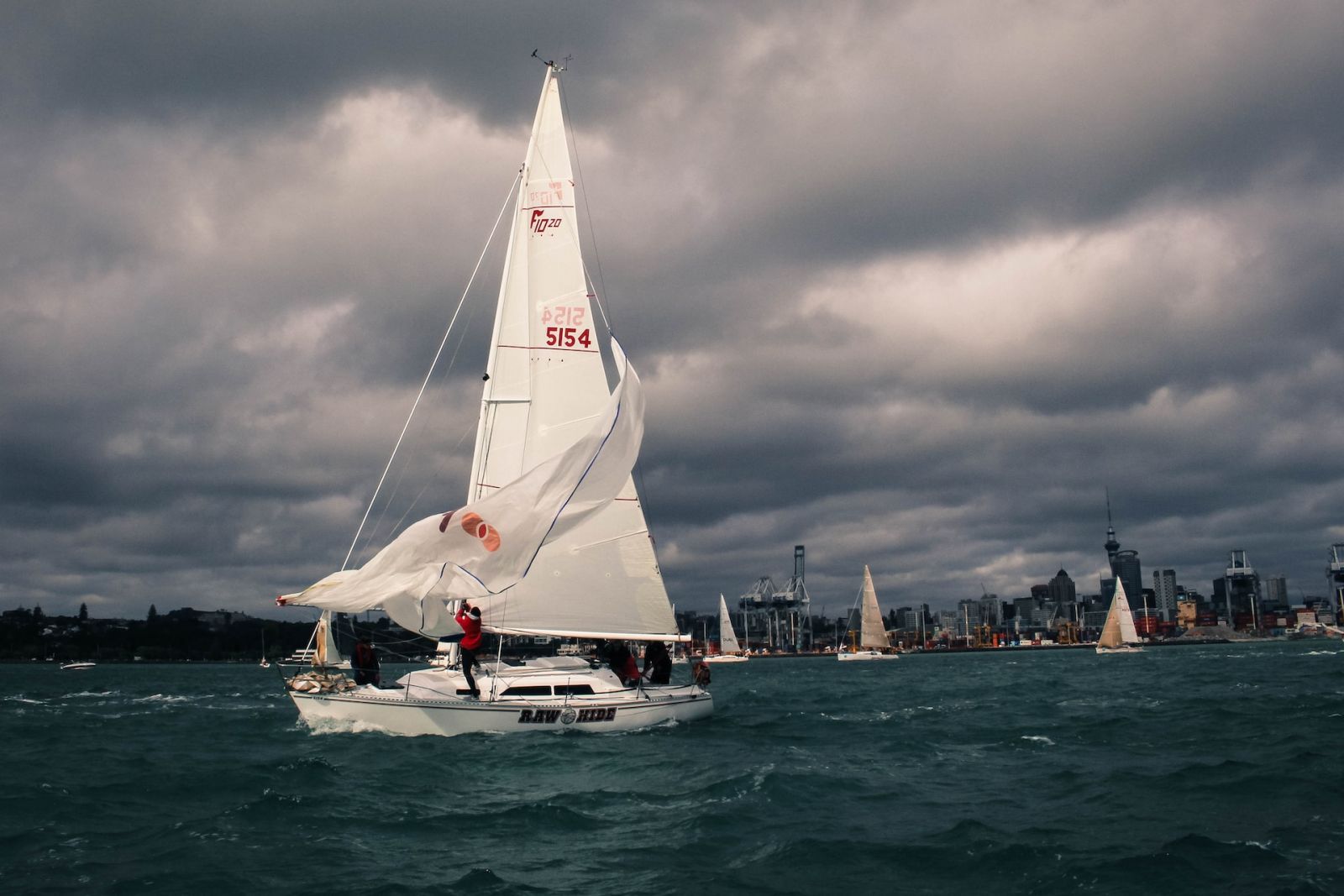
Here are some essential tips to keep your boat in top shape, and ensure its long life and performance during solo journeys:
Regular inspections : Make it a habit to perform a thorough inspection of your sailboat periodically. Examine the rigging, sails, hull, and all mechanical components. Routine inspections allow you to detect any signs of wear, damage or potential problems before they escalate.
Cleaning : Keep your sailboat clean by washing it regularly with freshwater and appropriate cleaning solutions. This simple practice prevents the buildup of dirt, salt, and other debris, which can cause corrosion and damage to your vessel over time.
Checking the bilge : Ensure that your bilge pump is working efficiently and that there's no water accumulating in the bilge area. If there are any signs of water accumulation, investigate the source and address any leaks or issues promptly.
Servicing the winches : Winches play a crucial role in your sailboat’s performance, so it’s essential to inspect, clean, and grease them regularly. This practice will guarantee their smooth operation and prolong their lifespan.
Sail care : Inspect your sails frequently for any tears, wear, or damage. Repair or replace them as necessary. To protect your sails from the sun’s harmful UV rays, always use a sail cover when not in use.
Keeping records : Maintain a logbook to document all maintenance tasks, inspections, and repairs. Not only will this help you keep track of what has been done, but it will also provide valuable information if you decide to sell your sailboat in the future.
Leave a comment
You may also like, what is bluewater sailing.
It's easy to confuse offshore sailing with bluewater sailing - and it's no wonder. Many people do, including myself. So I've decided to list the difference once and …

13 World-Famous Bluewater Sailboats Under 40 Feet
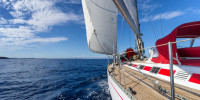
What's the Best Keel Design for Bluewater Sailing?
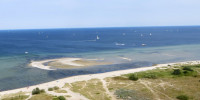
Different Types of Sailing and Racing Explained
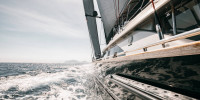
41 Sailboat Cruising Essentials for Long Trips
10 Best Sailboat Brands (And Why)

There's no denying that sailors are certainly a passionate bunch. We’re so passionate about our boats that we always try going for the best sailboats. To make it a lot easier for you, here are the best sailboat brands.
Owning a sailboat is an indulgence that many of us only dream about but very few ever have the privilege of sailing the seas in what they can actually call their own.
While there's nothing wrong with renting a sailboat, the honor of owning one is certain what many sailors dream of.
With a perfectly crafted sailboat as company, gliding through the water, waves, and wind brings some sort of unmatched comfort and peace.
Add this to the fact that sailing takes you far away from the daily hustles and bustles that we've become accustomed to in our daily lives and you'll see why the life of sailing is very appealing to the masses.
But without a proper sailboat, all this fun and the good life of sailing are thrown out of the window.
Contrary to the widespread opinion, owning a sailboat isn't beyond anyone's reach. It's something that we can all achieve. But before getting into that, it's important to know some of the best sailboat brands.
The best sailboat brands will make your life as a sailor a lot easier and more fun. The best sailboat brands have, for decades if not centuries, mastered the art of woodworking. They've dedicated their skills and immense amount of their time to designing and manufacturing nothing but the best quality of sailboats in the industry.
So if you've been looking for the best sailboat brands from all over the world, you've come to the right place. We'll discuss the best of the best, something that will give you a perfect getaway from your normal life.
Table of contents
Must-Have Features for Your Sailboat
Before highlighting the best sailboat brands, it would be appropriate to jog your mind a little with some of the features that must be available in your sailboat.
Choosing a sailboat can sometimes be a matter of compromises. In other words, it's sometimes sensible to accept that a sailboat cannot have all the features that you desire.
As such, it's all about going with a sailboat that has the features that matter to you most.
For this reason, let's look at the most basic features that can make the difference in both safety and comfort while improving your sailing experience.
A Safe and Comfortable Sailing Cockpit
You'll most definitely be spending a huge amount of time in the cockpit. Whether you're keeping watch, trimming sails , helming, or just enjoying the scenery, there's no better place to do all these than from the cockpit. That being said, a good cockpit should have the following.
- Have a good depth for safety reasons and adequate drainage
- Should give you a quick and easy access to jammers, cleats, and other important parts of the winch system
- Should have a seat or seats that are about 35 cm high, 50 to 55 cm wide to provide ideal support
- The seats should be adjustable to offer maximum comfort and allow you to change your position
GPS Chartplotter
Use a GPS Chartplotter once and your sailing will never be the same without it. It not only allows you to map a course but is also a great way of ensuring that your sailboat exactly follows that course. It also gives you constant updates on ocean conditions, weather conditions , and potential hazards such as deadly currents and sandbars.
A GPS Chartplotter is also an important safety device that can help you in some very critical situations while out there on the water.
For instance, it has a man-overboard button that is essentially meant to allow you to receive coordinates of the exact location should someone fall off your boat.
Electric Winch System
This is an amazing addition to any sailboat. It allows you to sheet a jib even in high and strong winds with a simple press of a button. It also gives you the chance of trimming a mainsail easily while still carry out other essential tasks in the sailboat.
An electric winch system can be of great importance, especially if you're short on crew. This is because it can free up some crew members to carry other important tasks. In other words, it can make duties that would otherwise require more crew members a lot easier.
More importantly, an electric winch system can maintain safety even in the roughest of conditions, thereby preventing you and your crew from getting injured. In essence, an electric winch system will make your sailing a lot safer, less stressful, and more enjoyable.
Reverse Osmosis Watermaker
This is a very valuable accessory, especially if you're going on long sea voyages. You can spend days on end without drinking clean and safe water.
As the name suggests, you can use this accessory to turn seawater into purified drinking water. It uses the reverse osmosis method that's essential not only in removing bacteria and parasites from the water but also in turning the water into purified and safe drinking water.
Even though this device is pricey, it's a great way to mitigate the over-reliance on huge water tanks. All you have to do is to ensure that it's properly maintained and you'll have an endless streak of safe drinking water no matter where you are.
Wide and Clutter-free Deck
While the deck is often an overlooked feature of a sailboat, it can be the difference between a great sailing experience and a stressful one. In essence, the deck of a sailboat should be wide enough and clutter-free.
This is significant as it can enable you to quickly access different parts of your sailboat with hindrance or getting tangled. As you can see, this is particularly important in improving safety and reducing stress.
With that in mind, make sure that the deck is organized in such a way that you can have easy access to sails, masts, and winches.
You should, therefore, avoid sailboats with decks that are designed in such a way that you have to climb on top of the cabin just to access these features. Needless to say, this can be quite unstable and very dangerous especially when conditions are rough.
The Best Sailboat Brands and Why
1. hallberg-rassy.
Hallberg-Rassy is a Swedish yacht maker that's very well-known in the blue water cruising circles for making some of the highest quality and sturdiest sailboats. For many sailors, this is the number one sailboat brand as it offers absolute comfort, utmost safety, and good and easy handling.
This brand is not only synonymous with sturdy construction but you won't worry getting soaking wet while out there on the water. This is because it has a well-protected deck and cockpit, finished with nice woodwork, and has a powerful engine with a big tankage just to ensure that you can go on long voyages.
When designing its sailboats, this brand has made it a norm to add some features that stand out from the rest. For instance, the bowsprit is an integral feature that makes sailing a Hallberg-Rassy quite easy and much enjoyable. This is because it grants easy access to and from the deck. Its electric anchor winches facilitate smooth maneuvering. Even more, its large steering wheels makes it much easier to control the boat even in the roughest of conditions. In essence, this brand has features that provide good control and an extra sense of safety.
Although this brand has evolved over the years, you'll easily recognize it even from a distance. And why is this? A Hallberg-Rassy never goes out of style. This is a unique sailboat brand that has always stayed true to its principles and concept. No matter which part of the world you go, Hallberg-Rassy will remain the undisputed king of blue water cruising.
2. Nautor's Swan
For over 50 years, Nautor's Swan has endlessly raised the sailing levels by designing and manufacturing new sailboat models that not only push the boundaries but also meet that many requirements and demands of sailors across the world. Thanks to its wide range of seaworthy, timeless, elegant, and highly-performing sailboats, the Nautor's Swan remains one of the best if not the best sailboat makers in the world.
Based in Jakobstad, Finland, this brand has severally set the industry standard with its speedy and sleek models such as the Swan 48, Swan 65, Swan 98, Swan 78, and Swan 120. These models have one thing in common: they never compromise on safety. As a brand that puts safety first, it ensures that its models are made of foam-cored glass fiber and reinforced both with carbon-fiber and epoxy. In essence, Nautor's Swan is widely revered for its unmatched seafaring and safety records.
Additionally, Nautor's Swan models are incredibly responsive. You can easily tell this just by the feel of the wheel. This brand has models that will gracefully slice through the biggest of waves with ease. That's not all; the interior of these models that are very comfortable even when the going gets tough. This is, without a doubt, a brand that strives to create self-contained worlds with each model.
3. Beneteau
This is perhaps the most selling sailboat brand in the world. For over a century now, this brand has based its models in a combination of simplicity and performance. This is a brand that will serve you just right across all latitudes and in all circumstances. Whether you prefer the Oceanis Yacht 62 or the Figaro Beneteau 3, this brand will never let you down on all fronts.
This brand revolves around a simple concept of creating a link around the world. From the deck space to its design and light, this brand does everything possible not just to uniformly transform life at sea but also to open doors to new horizons in a very luxurious yet practical way. Its models are designed with clear deck plans, stable hulls, simplified maneuvering and interior materials and equipment that can be easily personalized.
Whether you're looking for a racing sailboat or something that's designed to explore and enjoy the world in the company of friends and family, Beneteau is a true combination of sensations and simplicity. This is a brand that brings to the seas fun, simplicity, smartness, toughness, safety, intuitiveness, as well as dazzling reinvention.
4. Amel Yachts
Based on the ethos of designing and manufacturing comfortable, robust, and easy-to-handle boats, this French brand has, for over five decades, offered sailors and other sailing enthusiasts the perfect opportunity to explore the seas with the utmost quality, comfort, and more importantly, safety.
Using 100% French know-how, this brand has brought to the sailing world some of the best boats such as the Santorini, the Mango, the Super Maramu, and the Maramu. We would be doing this brand total injustice if we said that they're distinctive. Truth be told, there's nothing comparable to an Amel model. Well Amel was and still is, the ultimate standard by which other sailboat models are measured.
From items such as electric winches and furling, to generators, Watermaker , and washing machine down to the simplest of items such as towels. Spare filters, bathrobes, deck brush, and a boat safe, the Amel is in reality with what the real life of a sailor is and should be.
Although some may say that Amel still has room for improvement in terms of specifications and personalization, it cannot be denied that the Amel is a serious brand that designs and manufactures complete boats. With this brand, you'll be guaranteed of a higher degree of reliability, safety, and an edge of fun while out there on the water.
5. Hinckley Yachts
Based in Maine, United States, Hinckley Yachts is a brand that has been building robust, luxury, and safe sailboats for more than 90 years now. In its sailboat class, you'll find several sailboats that have classic shapes, inner strength, dramatic lines, and features that are absolutely essential in dealing with the challenges of the North Atlantic.
This brand has been successful in integrating impeccable craftsmanship with new technologies to ensure that their models always stand out while articulating advanced sailing practices, timeless aesthetic, robust construction, and the utmost safety. Whether you choose the Bermuda 50, the Sou'wester 53 or any model for that matter, you'll never be short of advanced performance based on the best design and technology.
In terms of features, this brand provides sailboat models with modern performance hulls. These hulls are constructed with inner layers of carbon, outer layers of Kevlar, and are aligned with computer-designed load paths. Every feature is designed without compromising comfort.
To this end, this brand offers you a perfect combination of both fun and sail. This brand offers more than just sailing. Instead, it offers a unique sailing experience that's combined with the pure joys of sailing in the blue waters with an ease of ownership and maneuverability.
6. Oyster Yachts
If you've been looking for luxury more than anything else, Oyster Yachts provides you with numerous solutions. This British brand is widely known for manufacturing a wide range of luxury cruising sailing yachts. Its sailboats are among the finest in the world and are immensely capable of taking you to some of the far-flung places in the world without having to worry about high winds and hellish waves.
Whether you choose the iconic Oyster 565 or the immense Oyster 595 you never fall short of experiencing the new world like never before. These are models that will enable you to own your adventure, choose your destination, set your courses, pick your anchorage, and stay safe at all times. If you want to hold the wheel and pull the sail while feeling the tang of salt spray on your face, Oyster Yachts is the way to go.
This is, unquestionably, a brand that's meant for you if you want to explore the seas in comfort, luxury and utmost safety. From craftsmanship, sailboat design, to hull, deck, and keel configurations, everything is designed to allow you to circumnavigate the world in comfort, elegance, and style.
7. Tartan Yachts
Based in Fairport Harbor, Ohio, there's arguably no better to begin your sailing adventures than with a sailboat designed and manufactured by Tartan Yachts. With several award-winning designs and construction, this brand is widely known for providing easy handling, great performance, and an ultimately stable platform.
This brand always strives to deliver a unique and the best possible experience to every sailor. As a brand, Tartan fully understands that every sailor has his/her unique sailing needs. As such every component of their models is designed with engineering levels that guarantee optimum performance, excellent on-deck visibility, and luxurious interior.
From the Tartan 5300, the Tartan 4300, the Tartan 345 to the New 365 and the Fantail, this brand makes it a priority to ensure that its models are among the strongest, lightest, and more importantly, the safest in the sailing industry. In essence, this brand can be ideal if you appreciate performance. It has rewarding sailing features both in narrow water lines and wider passages. Add this to its easy handling and you'll have a top-notch performer in virtually every condition.
8. Catalina Yachts
As one of the most popular boat manufacturers in the world, this American brand is widely revered for building the sturdiest boats that can hold up perfectly well in real-world conditions. These are generally family-oriented boats that are intelligently designed to ensure that your entire family can have fun out there on the water.
Some of the models include the cruiser series such as the Catalina 315, the Catalina 385, the Catalina 425 while the sport series include the Catalina 12.5 Expo, the Catalina 16.5, and the Catalina 14.2 Expo. As the current winner of the "Boat of the Year" Cruising World, you'll rarely go wrong with a Catalina model.
It offers a wide range of sailboat sizes that suits your lifestyle. This brand makes it a priority to ensure that all their models are not only safe but offer the best ownership and sailing experience. If anything, this brand is widely known to have one of the most excellent resale values in the sailing industry.
9. Island Packet Yachts
From the IP 525, the IP 439 to the IP 379, the Island Packet Yachts is a brand that encourages its customers not to keep the world waiting. This brand is meant for sailors who want to explore the world in utmost comfort and safety.
The first thing you'll notice in an IP sailboat is its large aft deck. This is not only perfect for sunbathing but can also serve you well if you want an impromptu dinner with friends and family while out there on the water. The living space is also large enough to carry most of your belongings, which is an added advantage especially if you've been planning to spend longer periods in the seas.
With modern evolution and refinement, as well as proven features, this brand is known to offer sailors maximum comfort, luxury, and safety. You'll have better access to the cockpit, have enough space, and are excellently designed to provide superior seafaring and the best features to enable you to spend extended periods when cruising.
10. Sparkman & Stephens
For more than 90 years, Sparkman & Stephens has been at the forefront of the belief that sailboat excellence goes beyond hull lines and deck plans. Instead, this brand believes in excellent naval architecture, innovation, sophistication, and beauty. This is a brand that has laid the foundation of sailboat as a sport not just in America but all over the world.
These models have graced the world for decades and bring immense pleasure to their owners in terms of innovation, performance, and excellence. Though rooted in tradition, the brand has pushed sophistication, technology, and sailing experience to a whole new level. You'll be a proud owner of the Sparkman & Stephens model.
There you have it; these are the best sailboat brands in the world. Although there are several other sailboat brands to choose from, the-above described brands stand shoulder above others in terms of quality, safety, performances and luxury.
Hopefully, you're at a much better place when it comes to choosing a sailboat that suits your lifestyle, needs, and budget .
Happy sailing!
Related Articles
10 Best Sailboats To Live In
Common Issues With Hallberg-Rassy Sailboats
Common Issues With Catalina Yacht Sailboats
Common Issues With Island Packet Yacht Sailboats
Daniel Wade
I've personally had thousands of questions about sailing and sailboats over the years. As I learn and experience sailing, and the community, I share the answers that work and make sense to me, here on Life of Sailing.
by this author
Best Sailboats

Most Recent

What Does "Sailing By The Lee" Mean?
October 3, 2023

The Best Sailing Schools And Programs: Reviews & Ratings
September 26, 2023
Important Legal Info
Lifeofsailing.com is a participant in the Amazon Services LLC Associates Program, an affiliate advertising program designed to provide a means for sites to earn advertising fees by advertising and linking to Amazon. This site also participates in other affiliate programs and is compensated for referring traffic and business to these companies.
Similar Posts

Best Small Sailboats With Standing Headroom
December 28, 2023
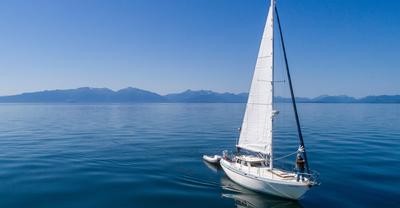
Best Bluewater Sailboats Under $50K

How To Choose The Right Sailing Instructor
August 16, 2023
Popular Posts

Best Liveaboard Catamaran Sailboats

Can a Novice Sail Around the World?
Elizabeth O'Malley
June 15, 2022

4 Best Electric Outboard Motors

How Long Did It Take The Vikings To Sail To England?

7 Best Places To Liveaboard A Sailboat
December 20, 2023

9 Best Trailerable Sailboats

IMAGES
VIDEO
COMMENTS
These classic bluewater sailboats can be found all over the world, proof they can go the distance. We counted 16 Amel Super Maramus and Super Maramu 2000s in our list of PPJ entries. Ready to join the cult of Amel? Read more about the iconic brand in Yachting World.
Have you ever wondered what brands and models are the most popular bluewater cruising boats?
With their distinctive blue cove line, these designs are famous for their seakindly behaviour, solid-as-a-rock build and beautifully finished, traditional interiors.
We will discuss the key characteristics that make blue water sailboats stand out, such as their hull design, rigging, and navigation systems. Additionally, we’ll explore the various types and sizes available to help you find the perfect fit for your sailing aspirations.
The most legendary solo bluewater sailboats are the Contessa 32, Westsail 32, Hallberg-Rassy 42F, Pacific Seacraft 37, Island Packet 38, Tayana 42, and Amel 54. These boats have it all: from robust designs to a world-renowned reputation for performance and reliability.
Daniel Wade. There's no denying that sailors are certainly a passionate bunch. We’re so passionate about our boats that we always try going for the best sailboats. To make it a lot easier for you, here are the best sailboat brands.